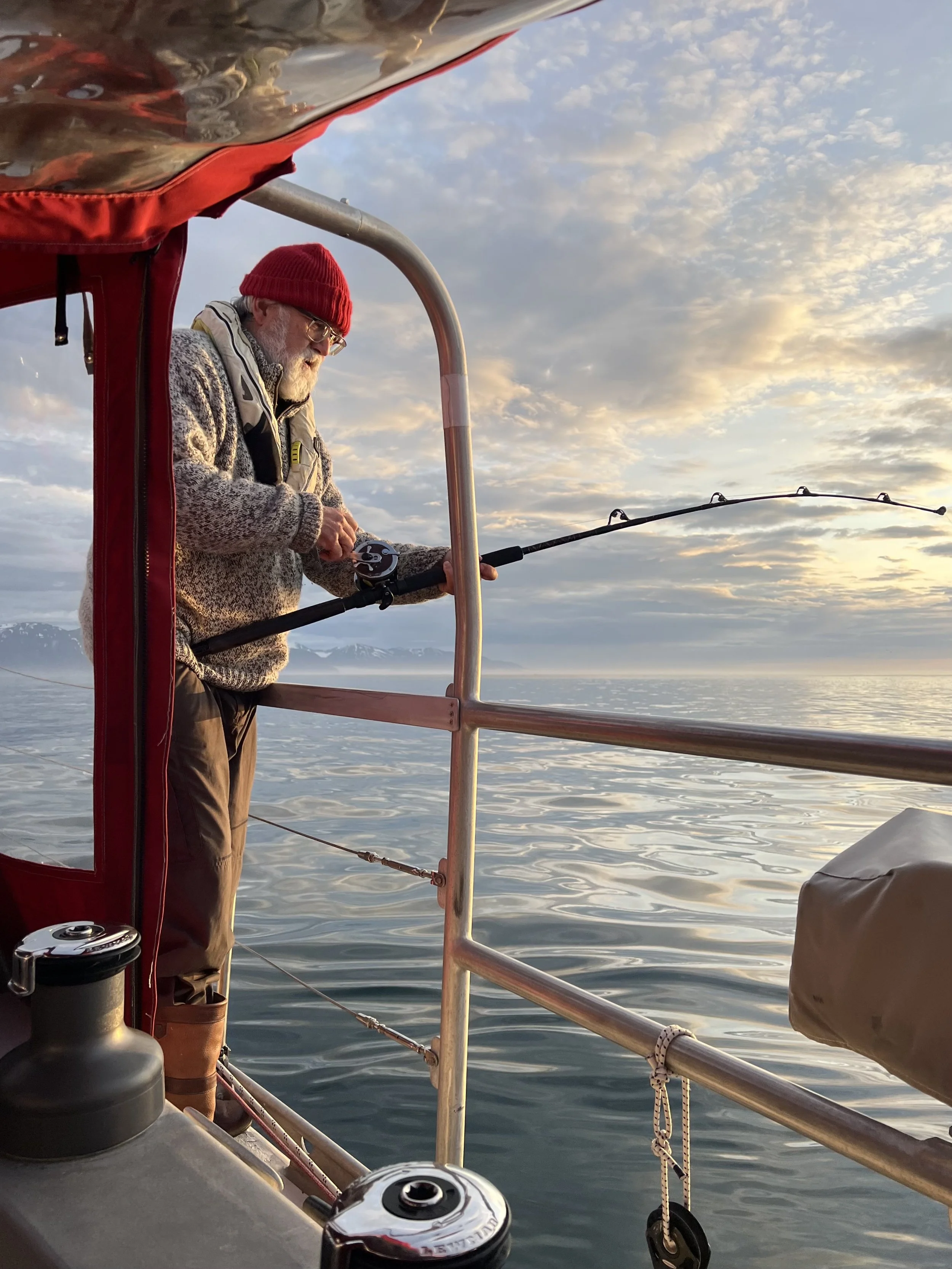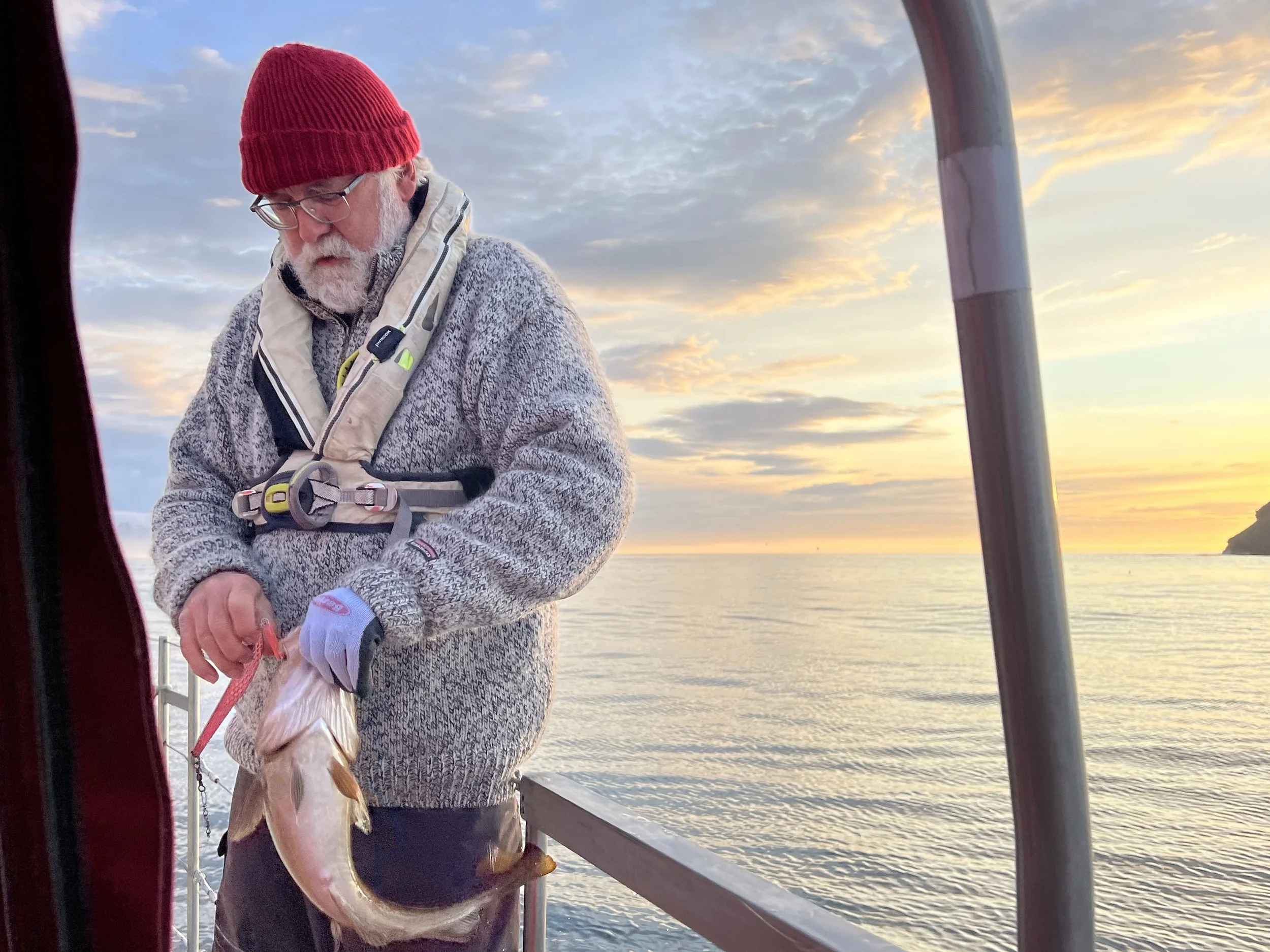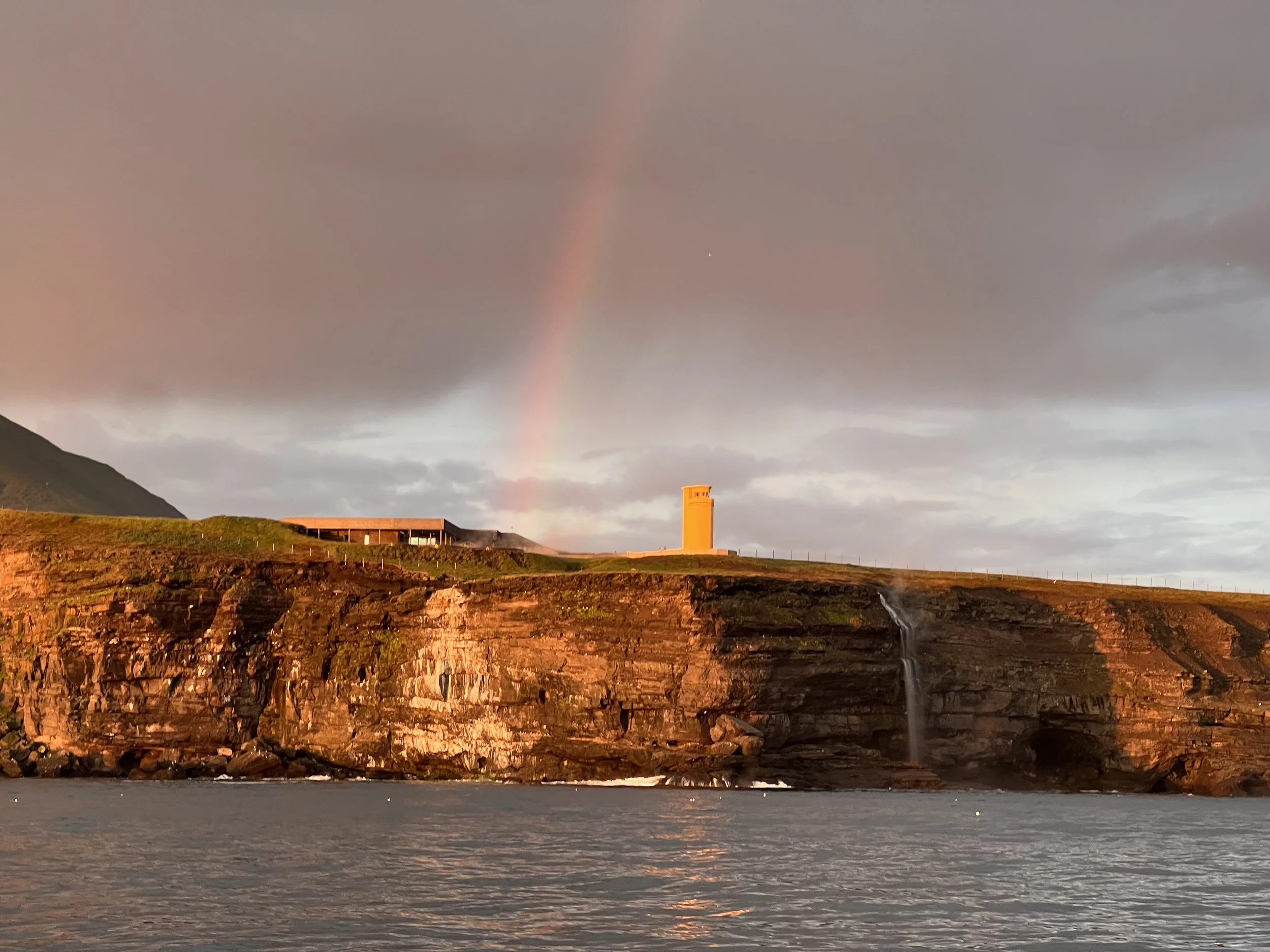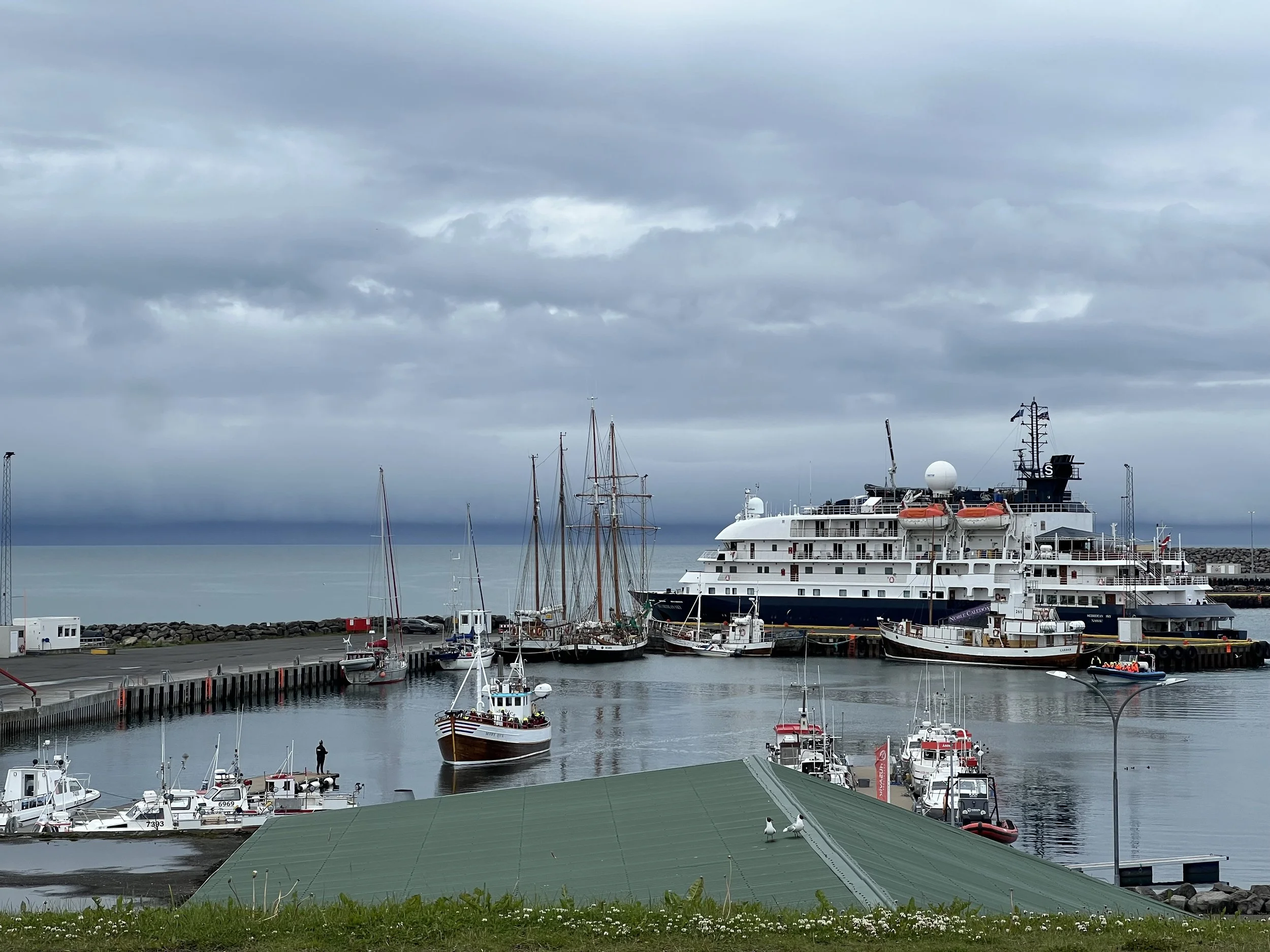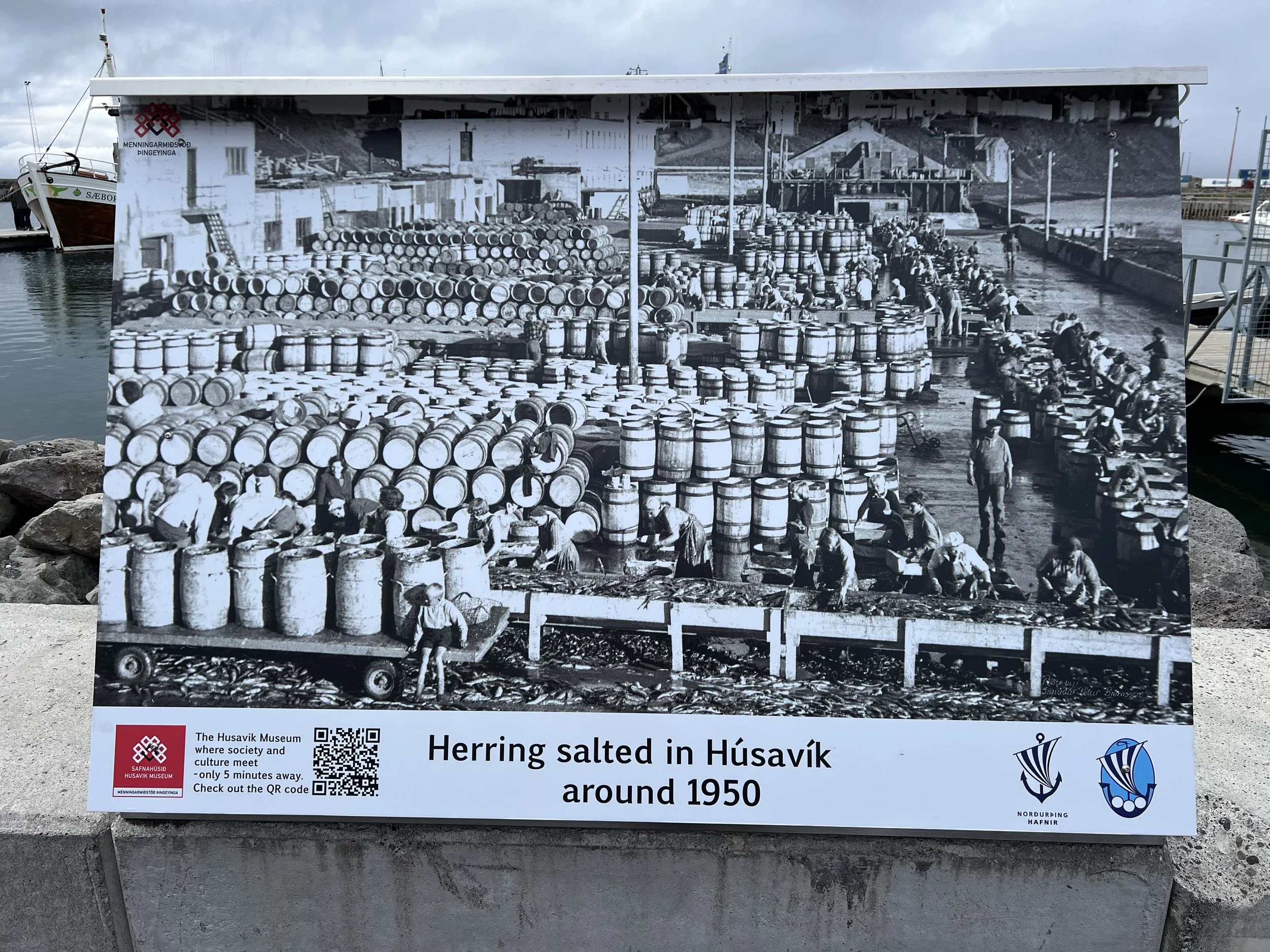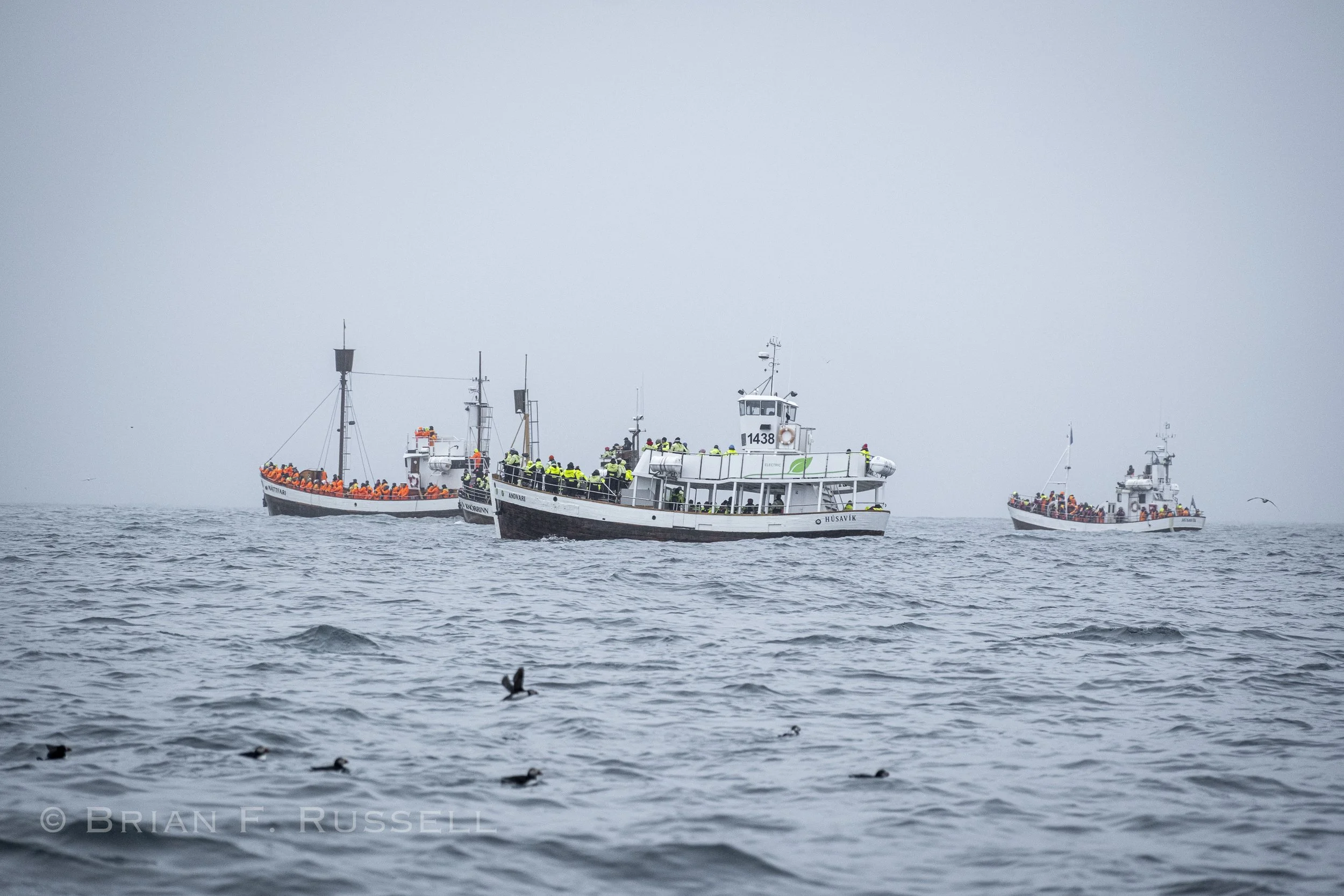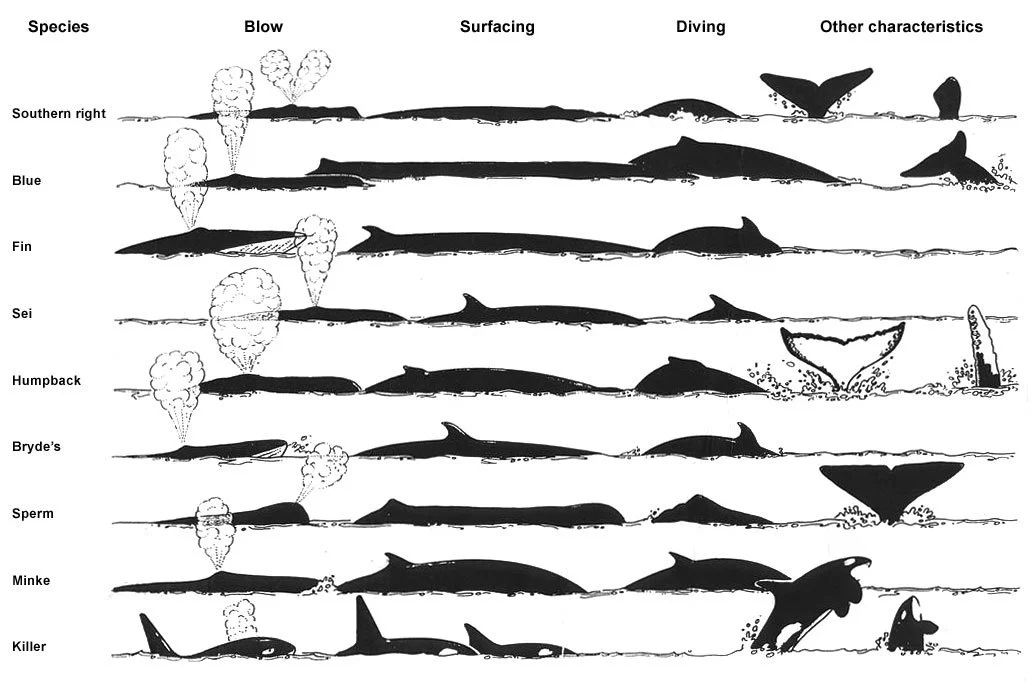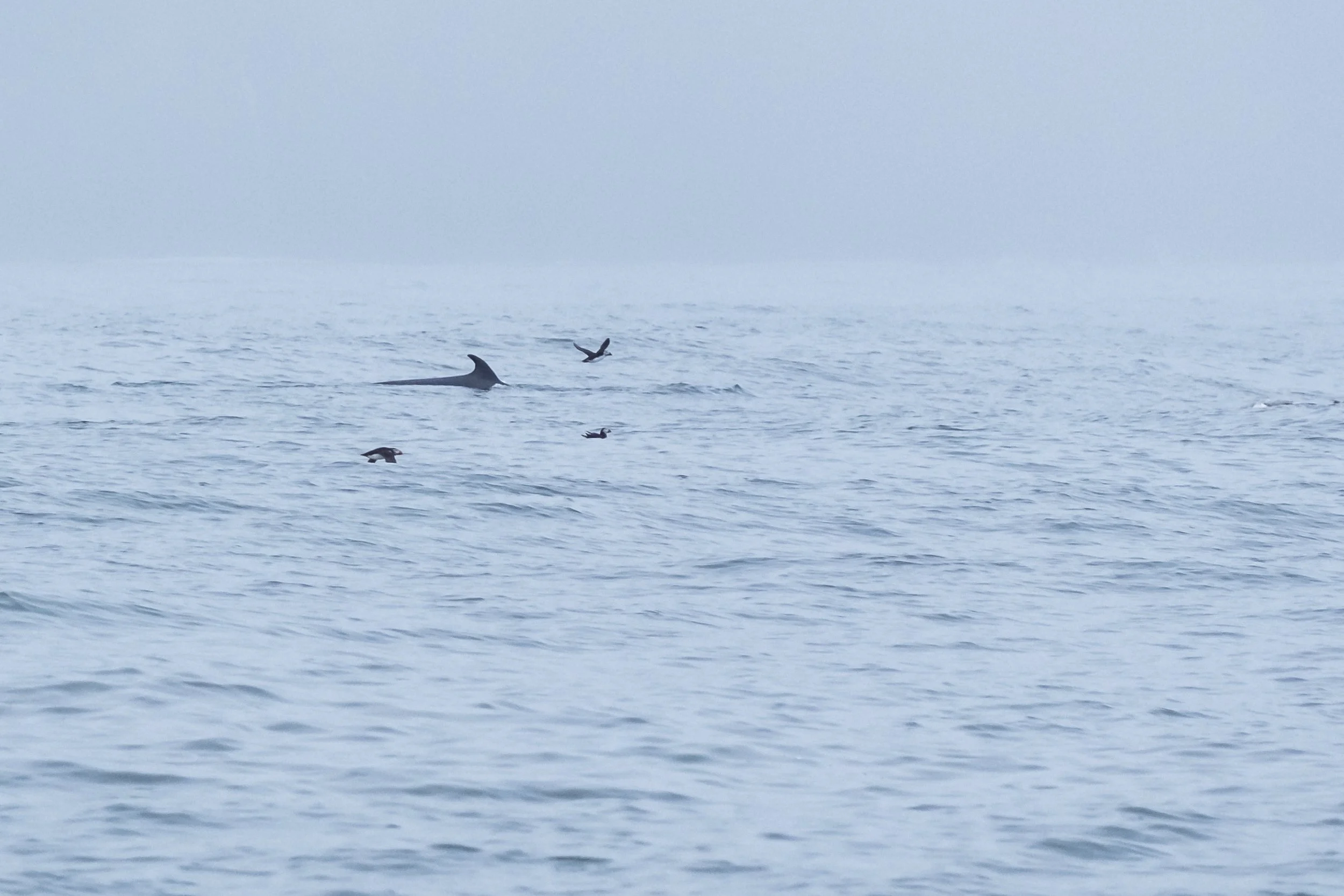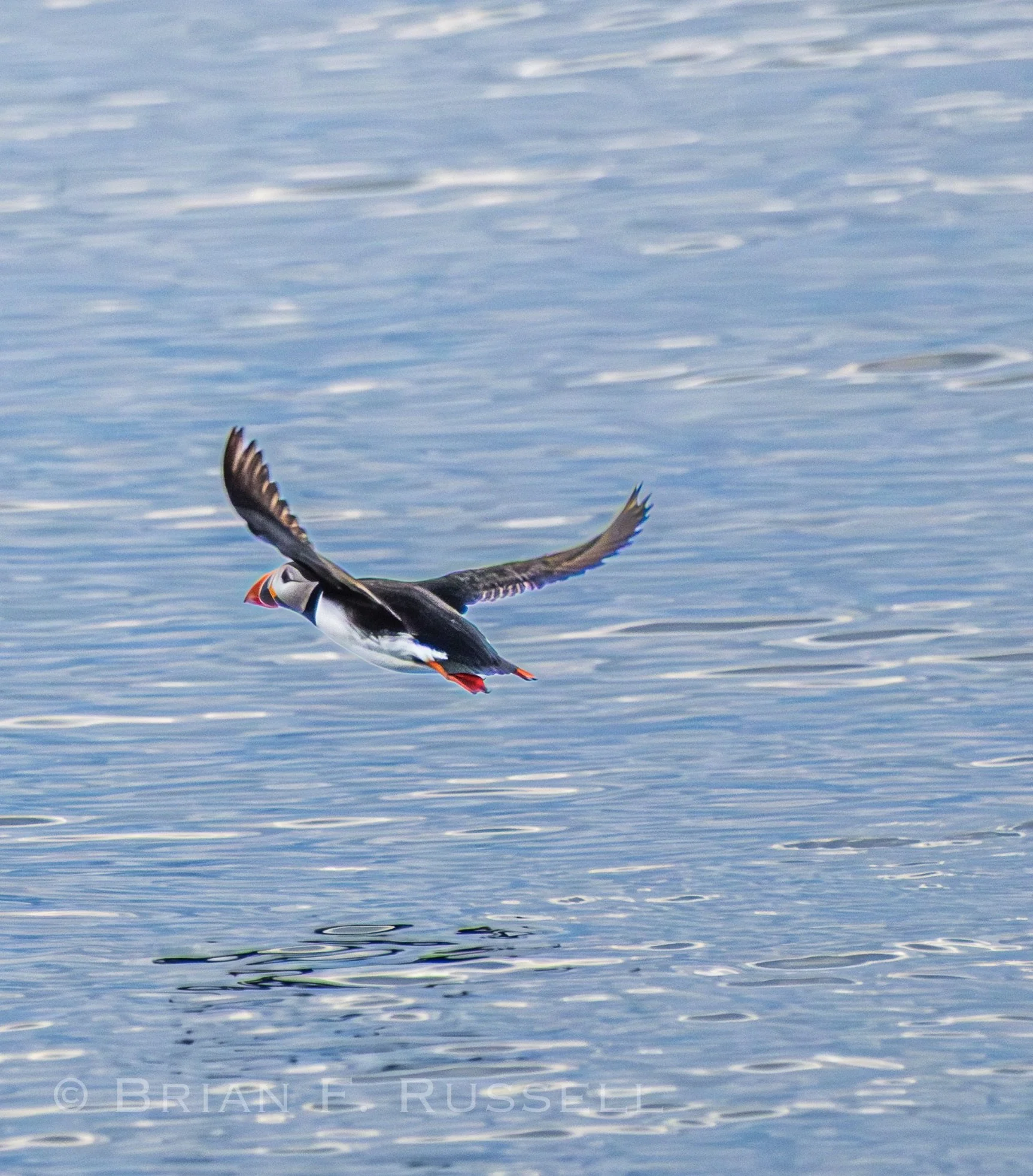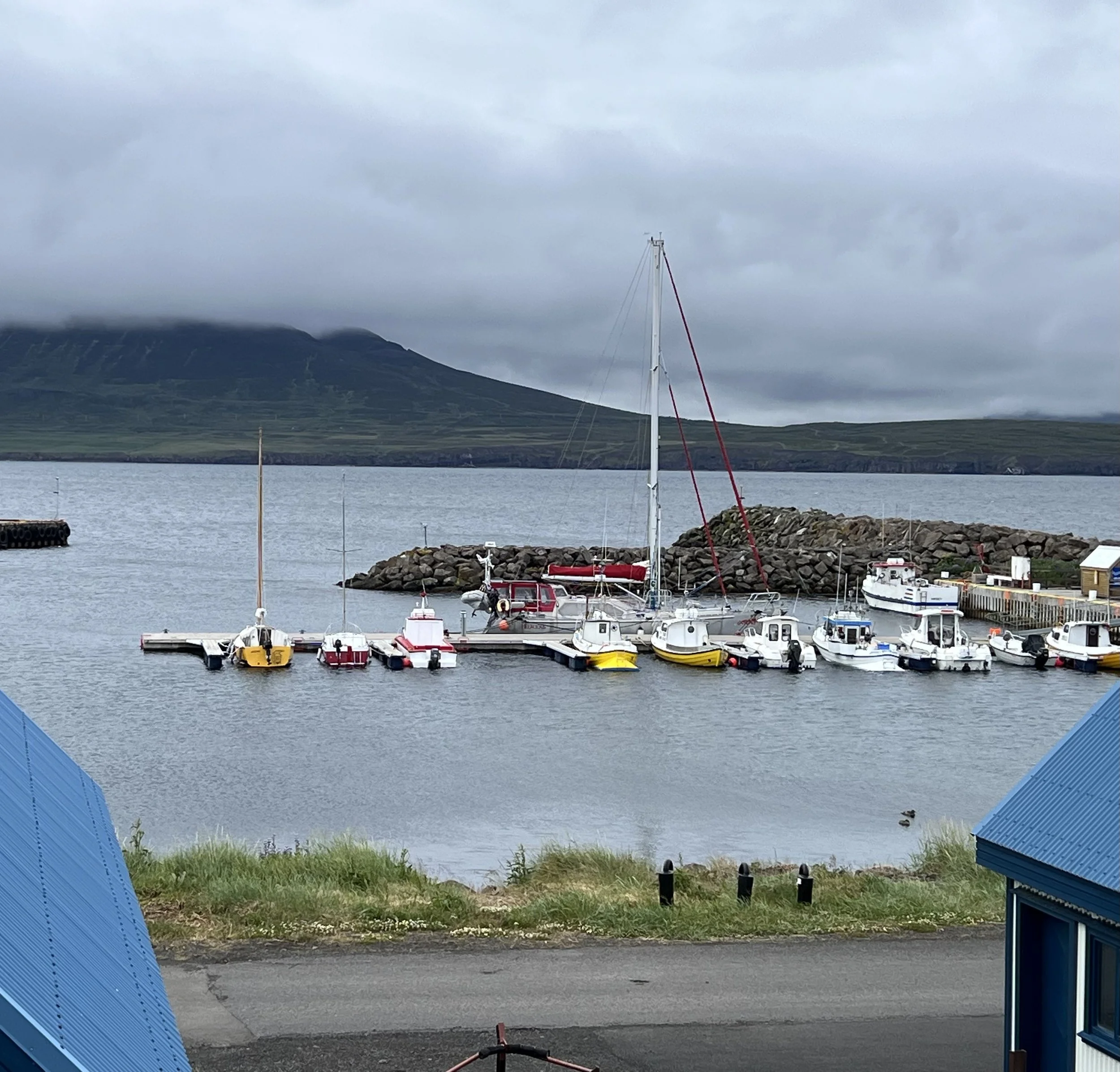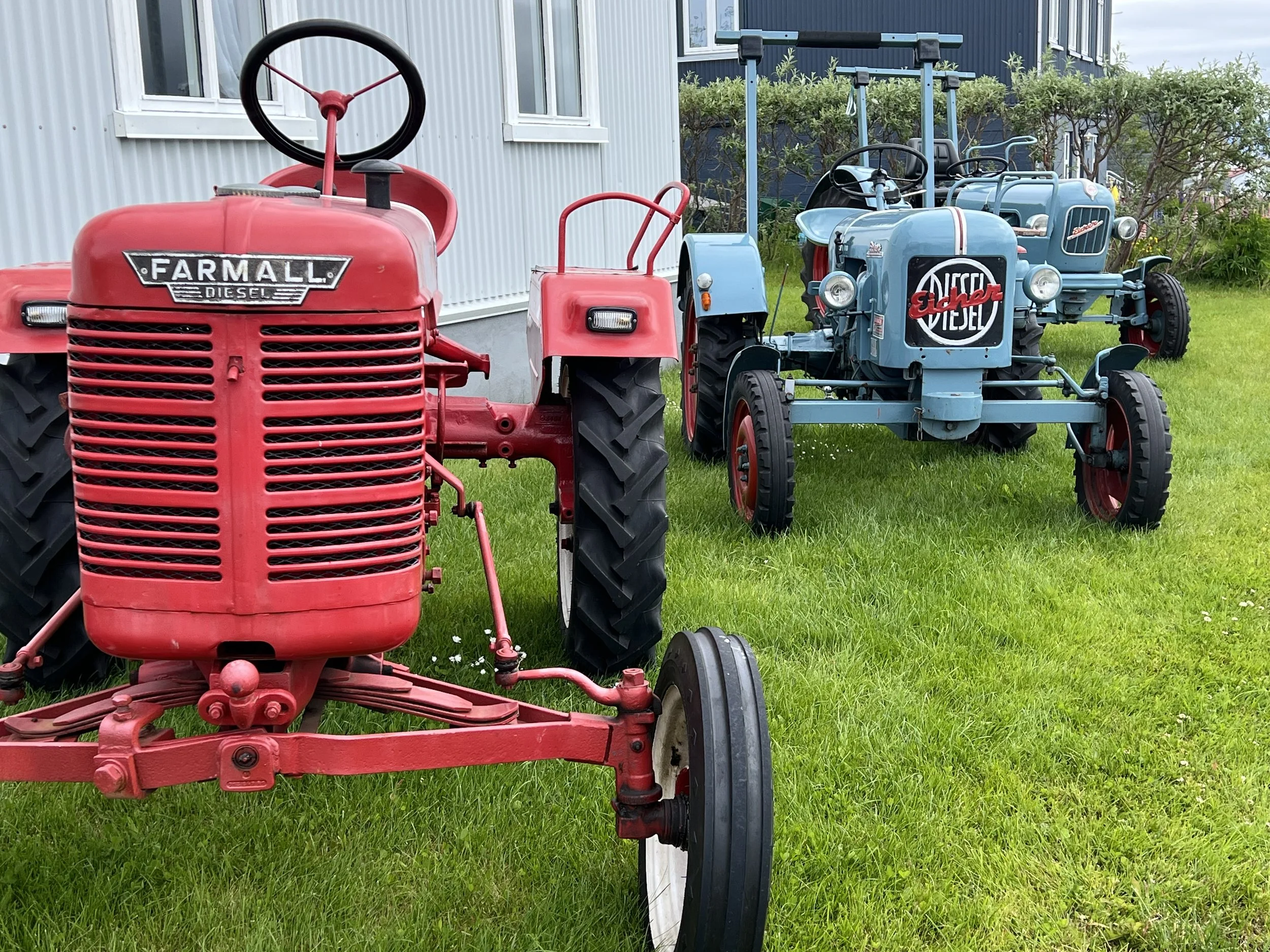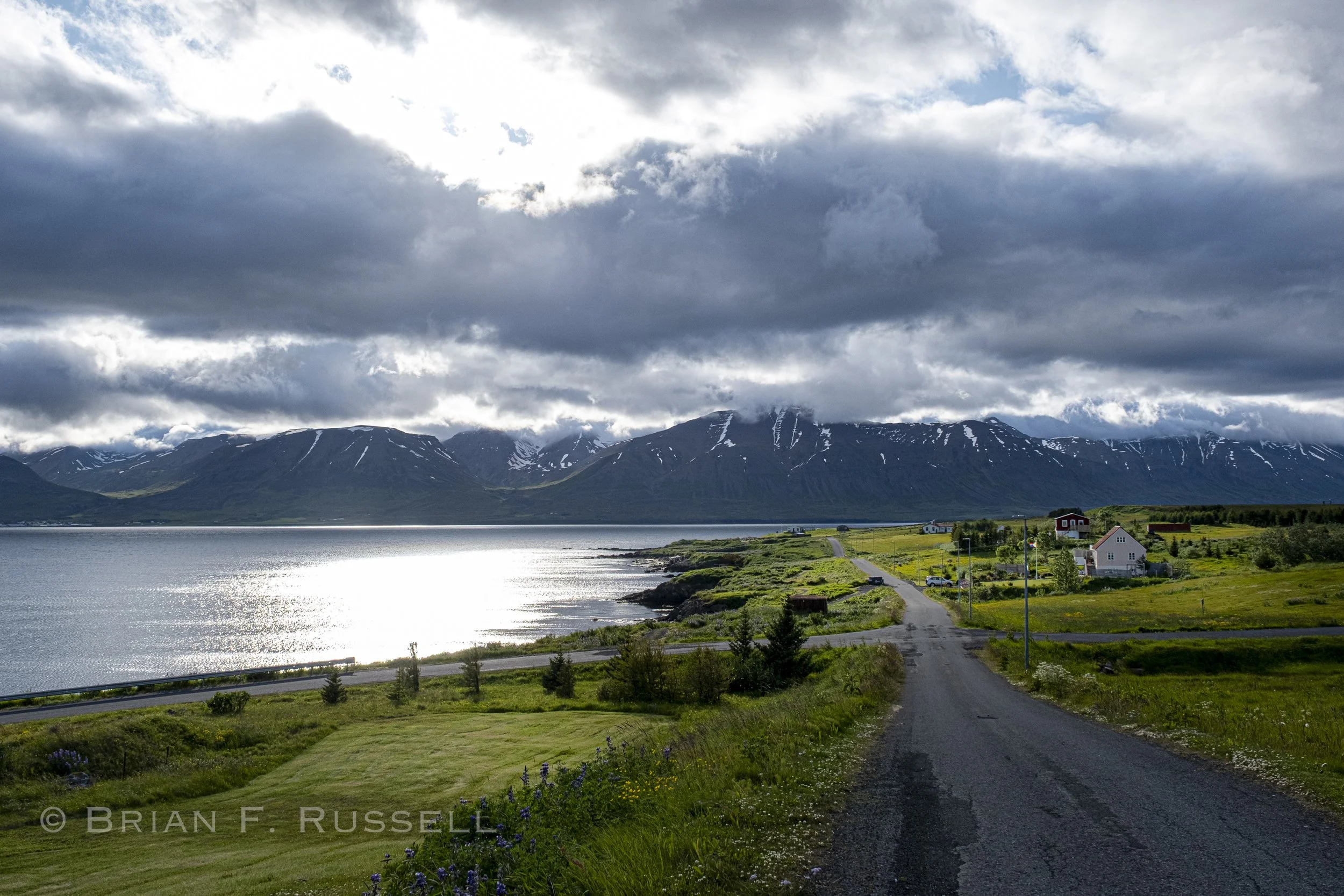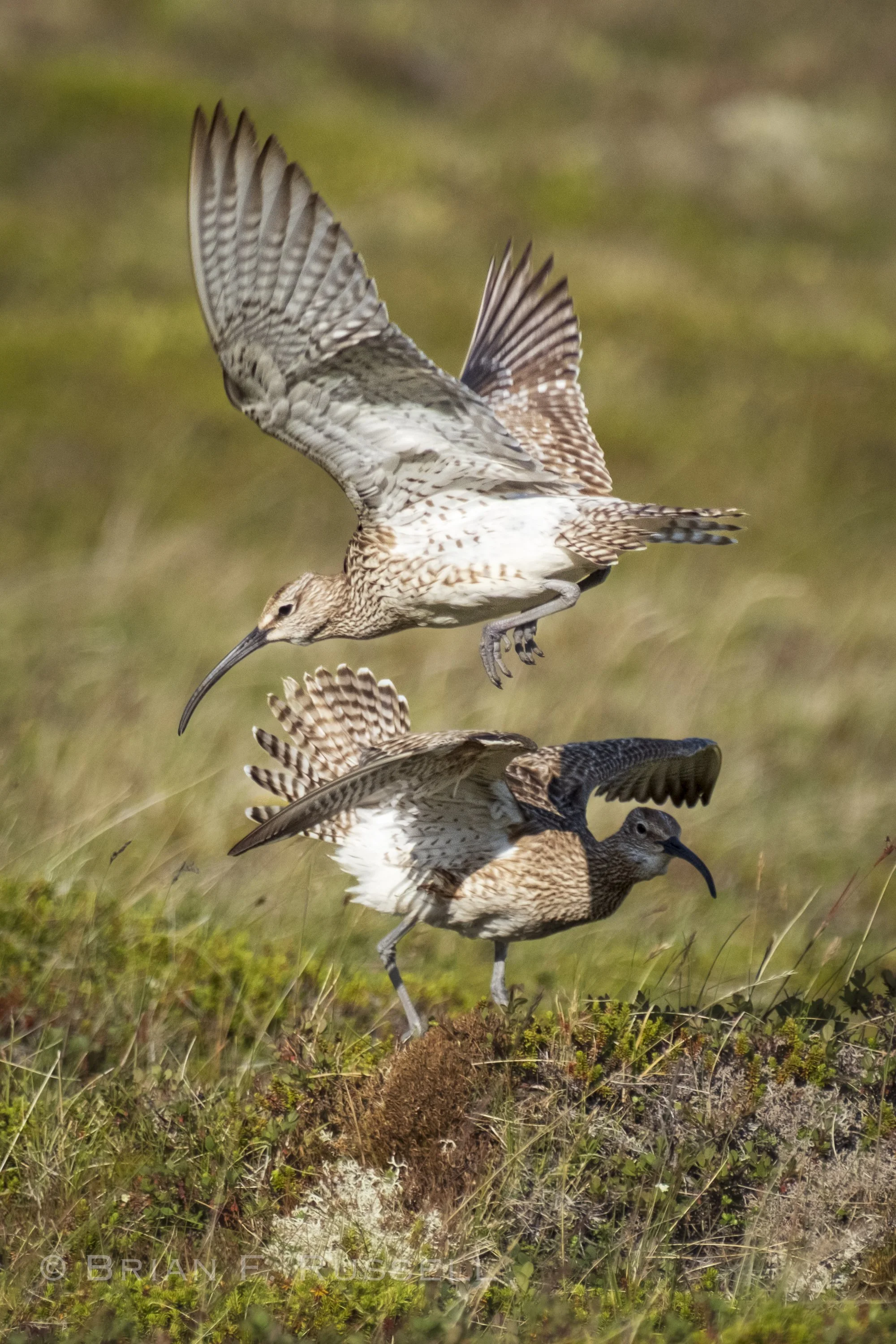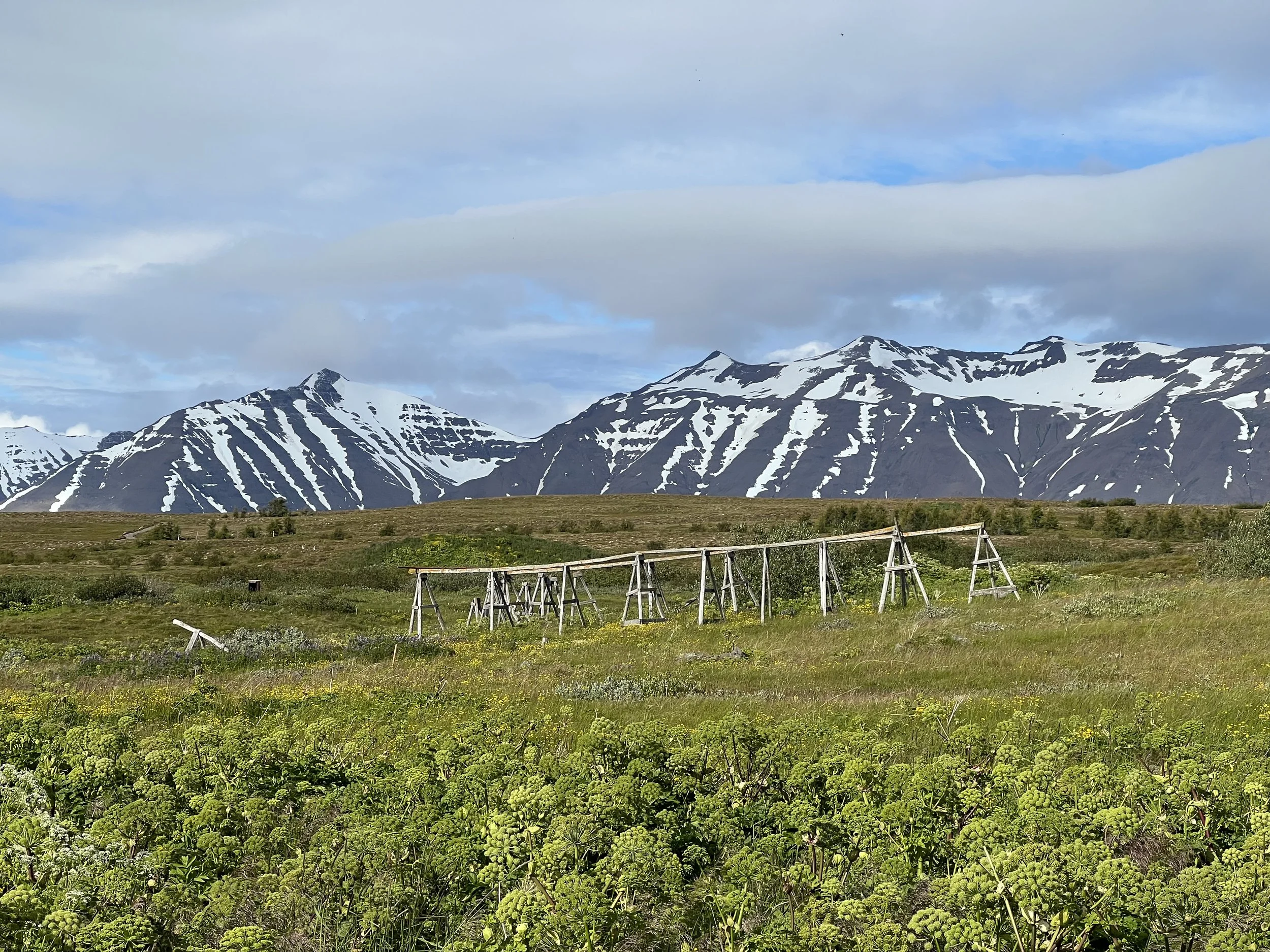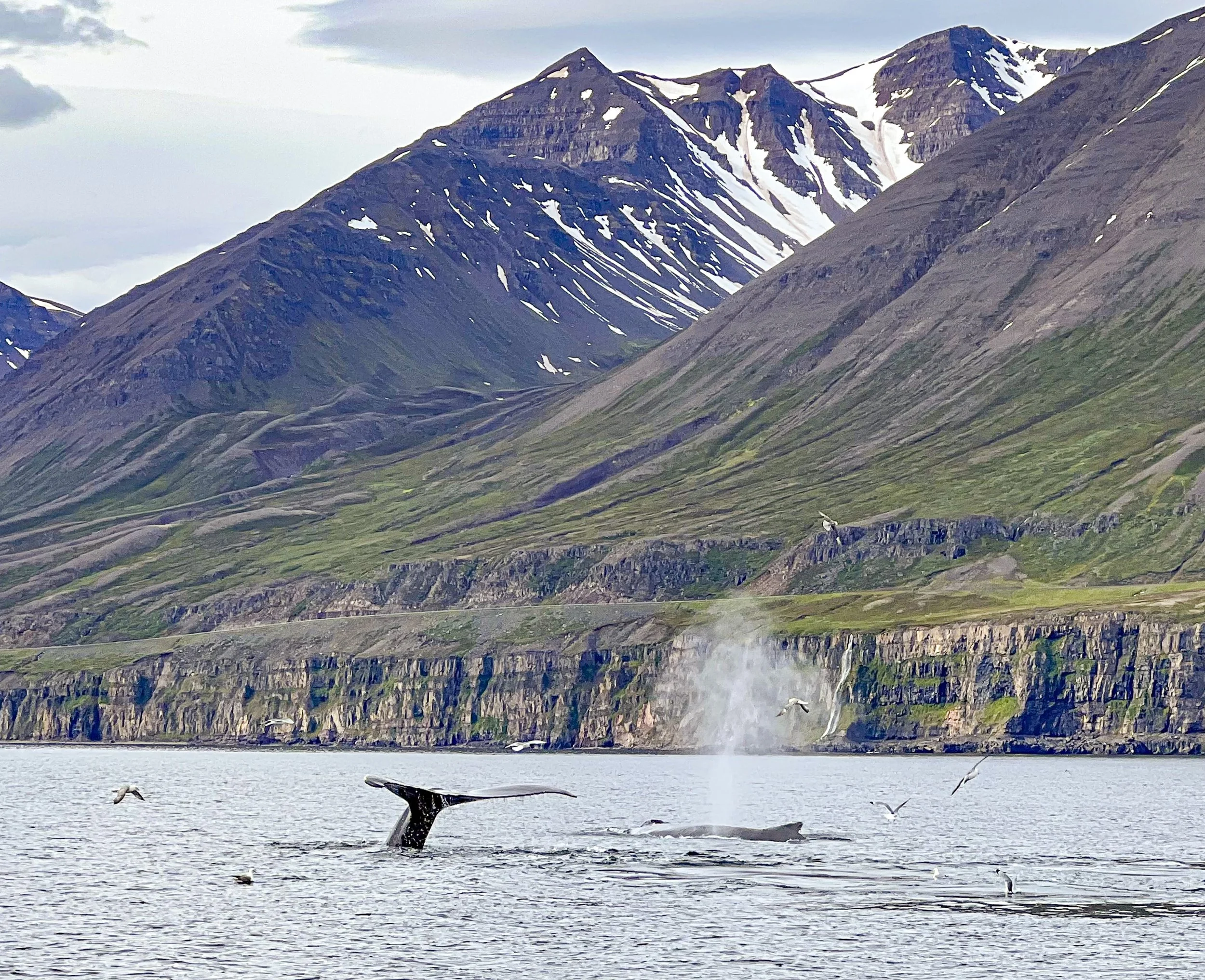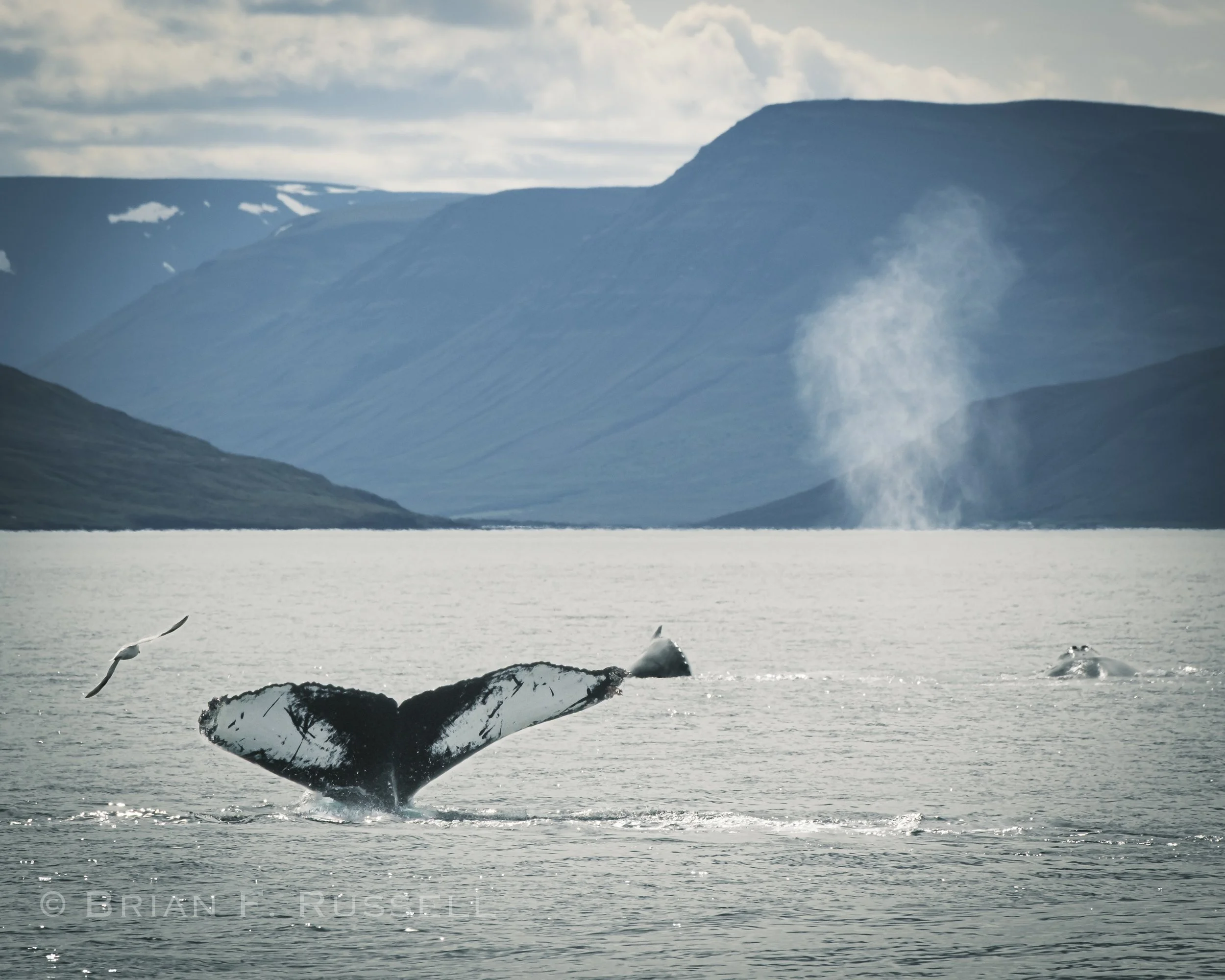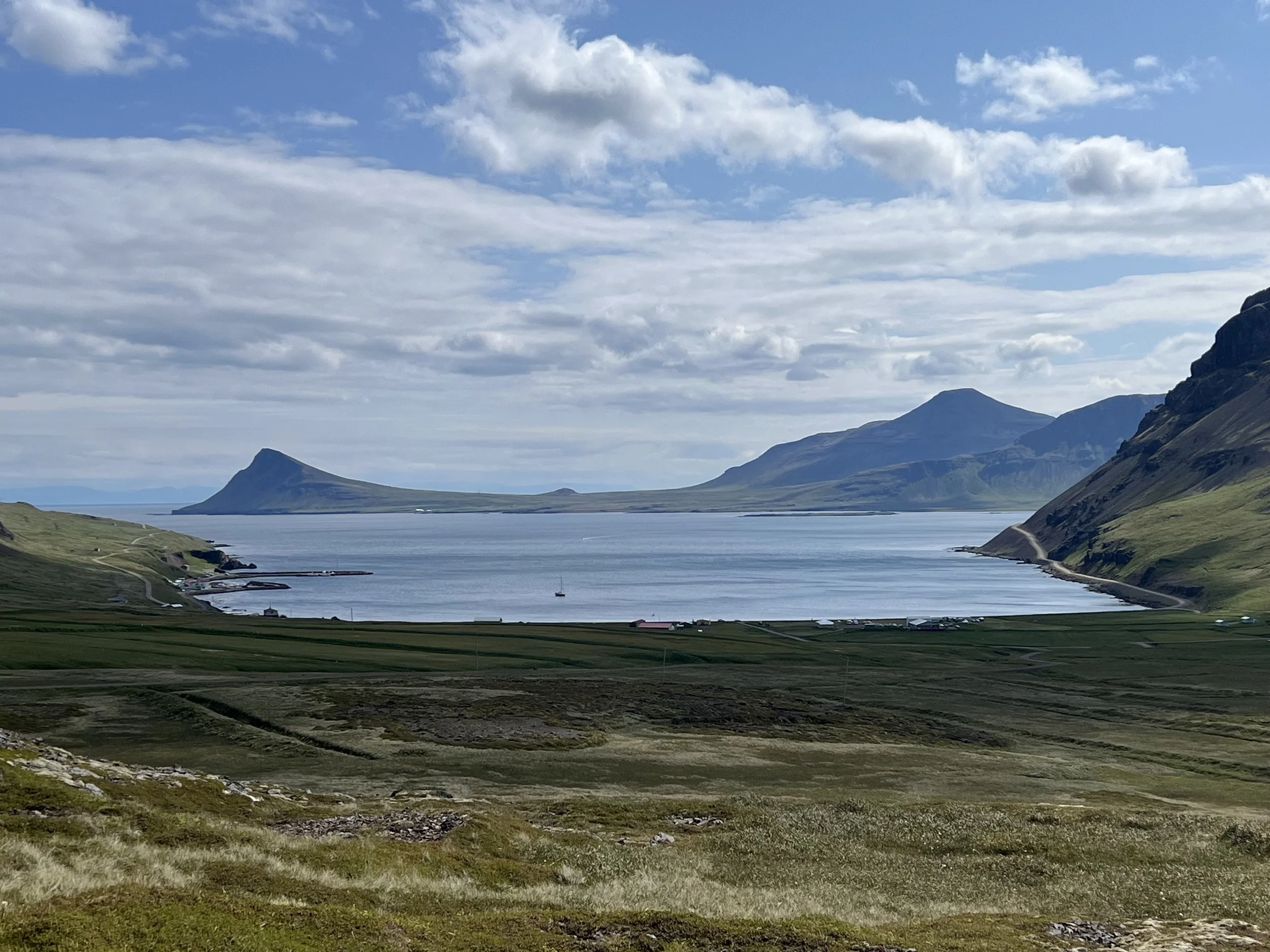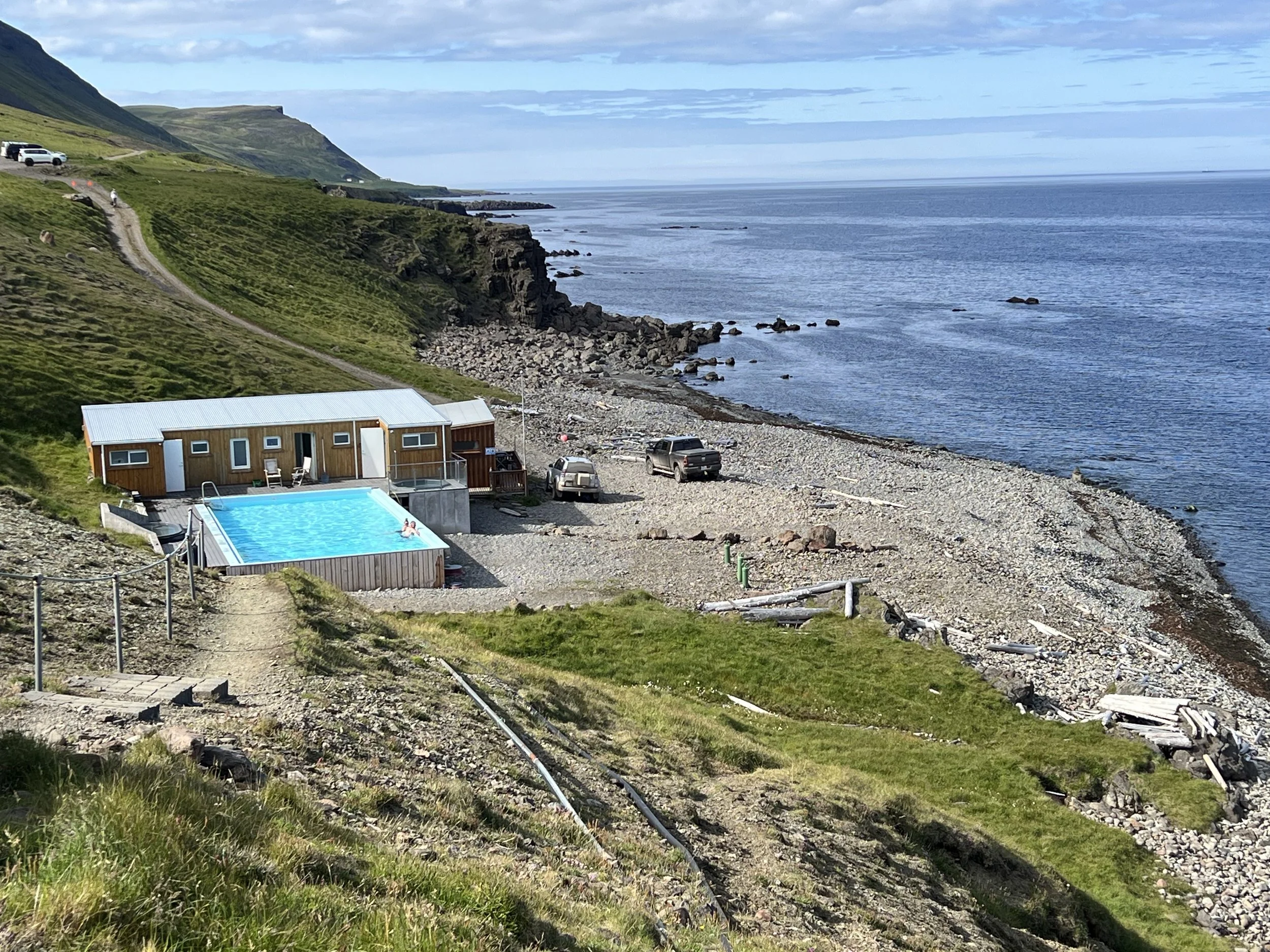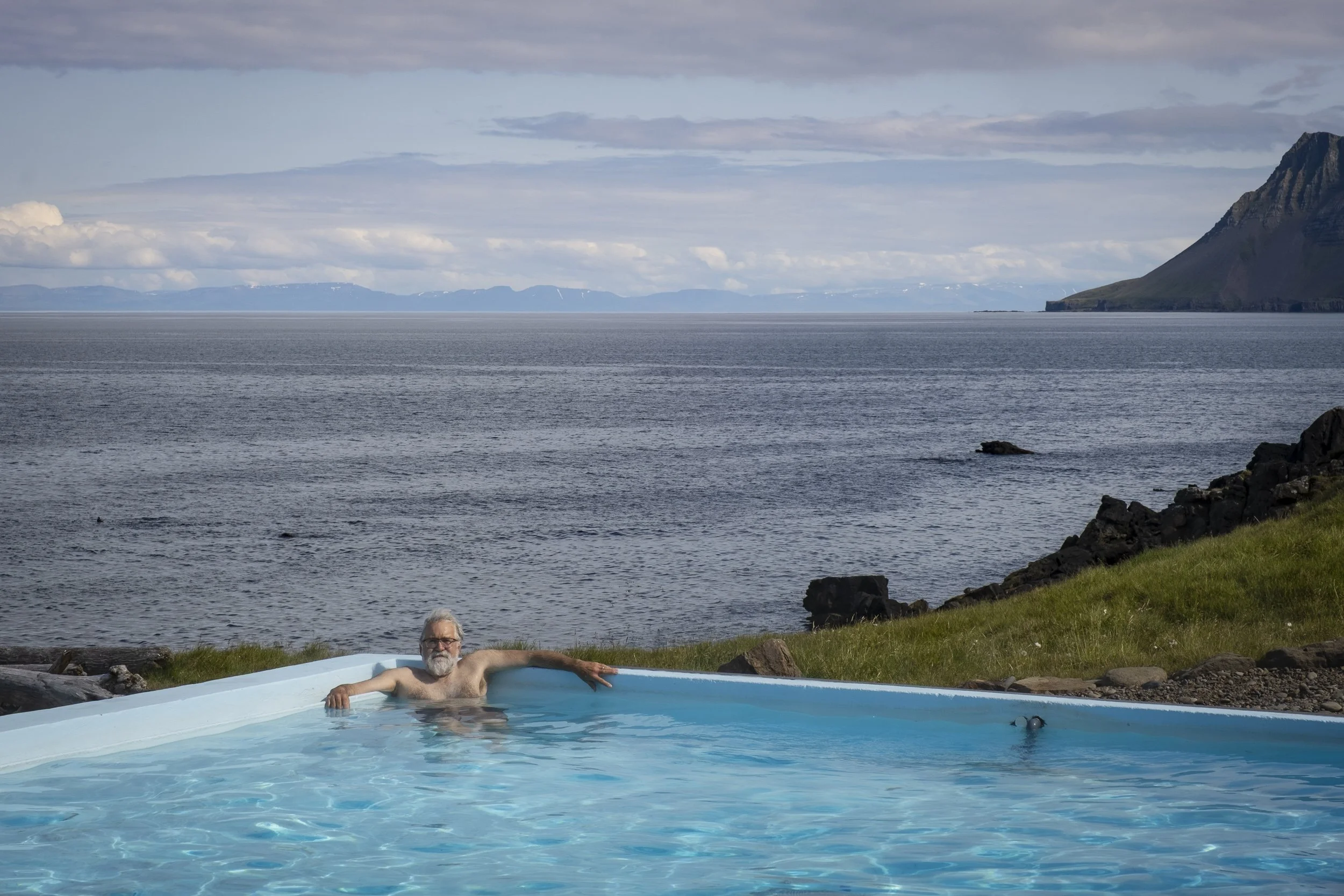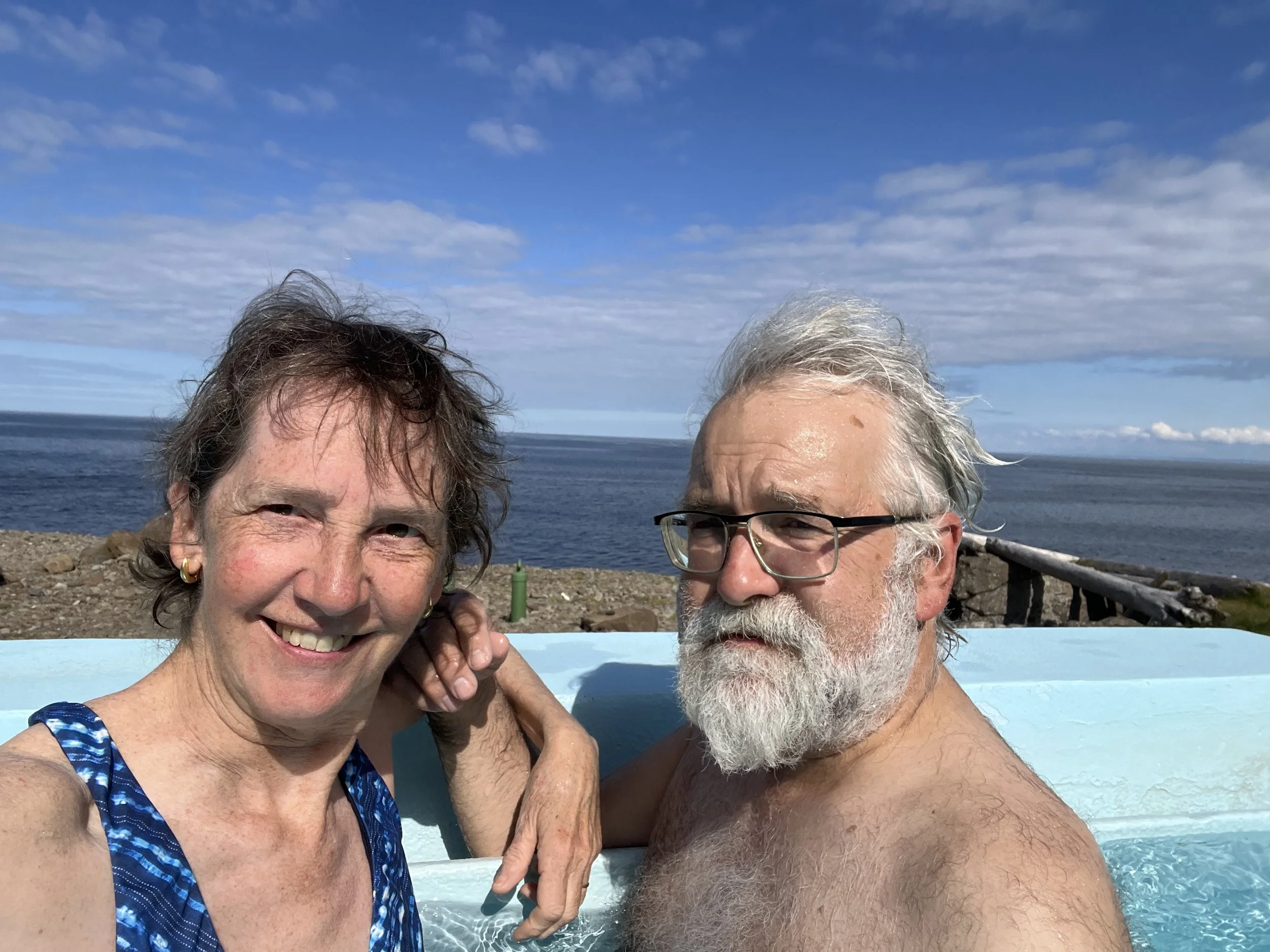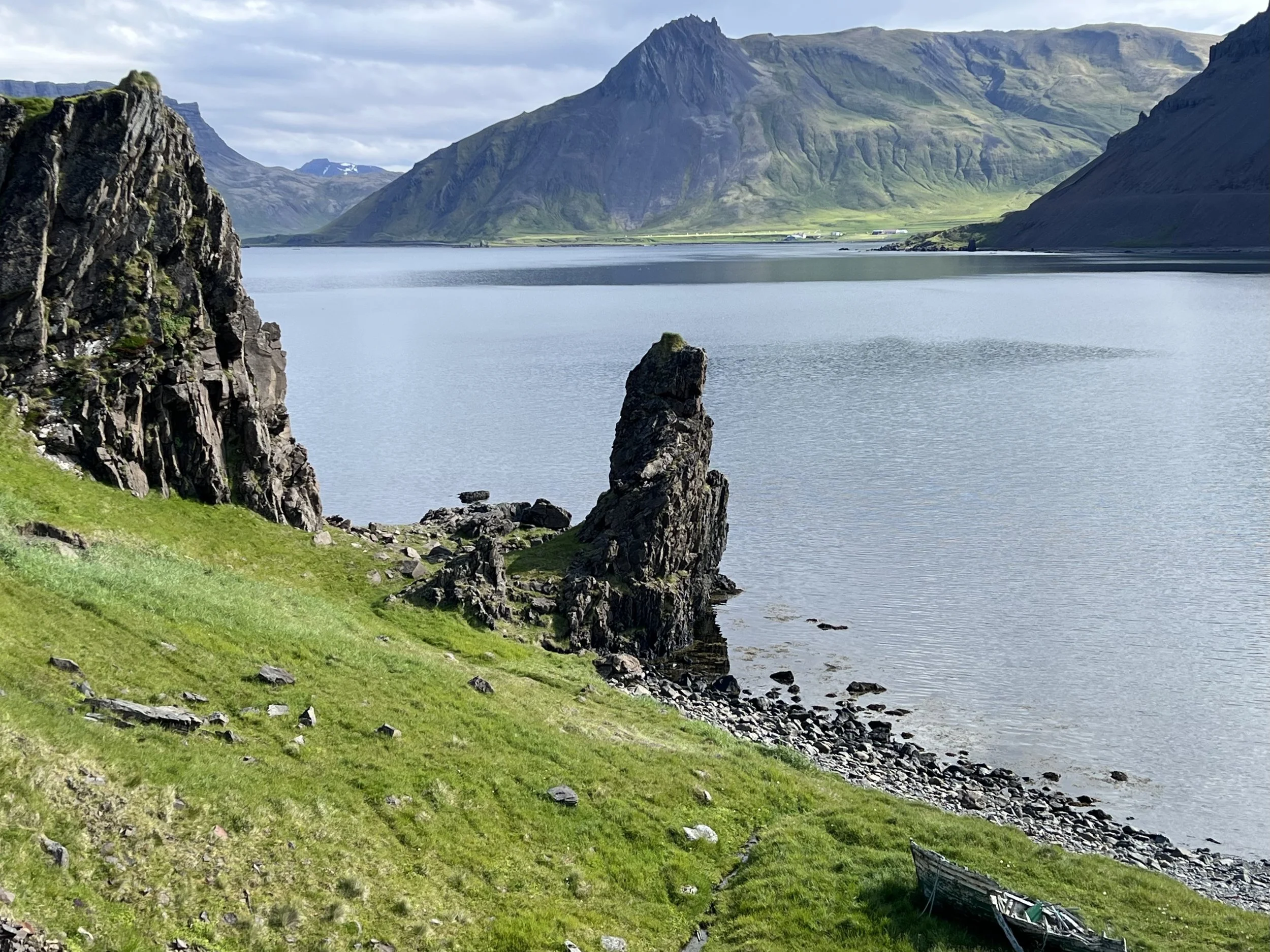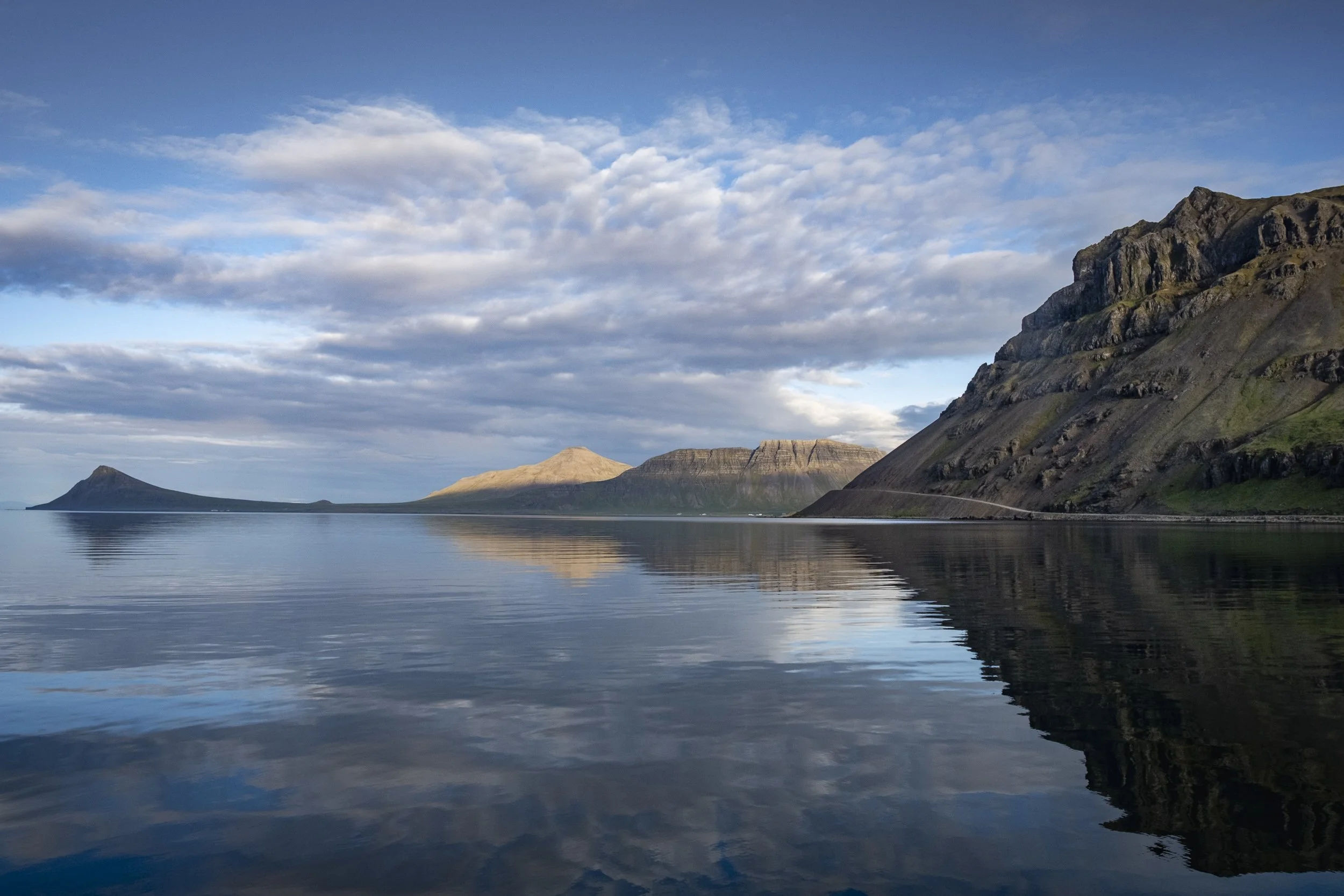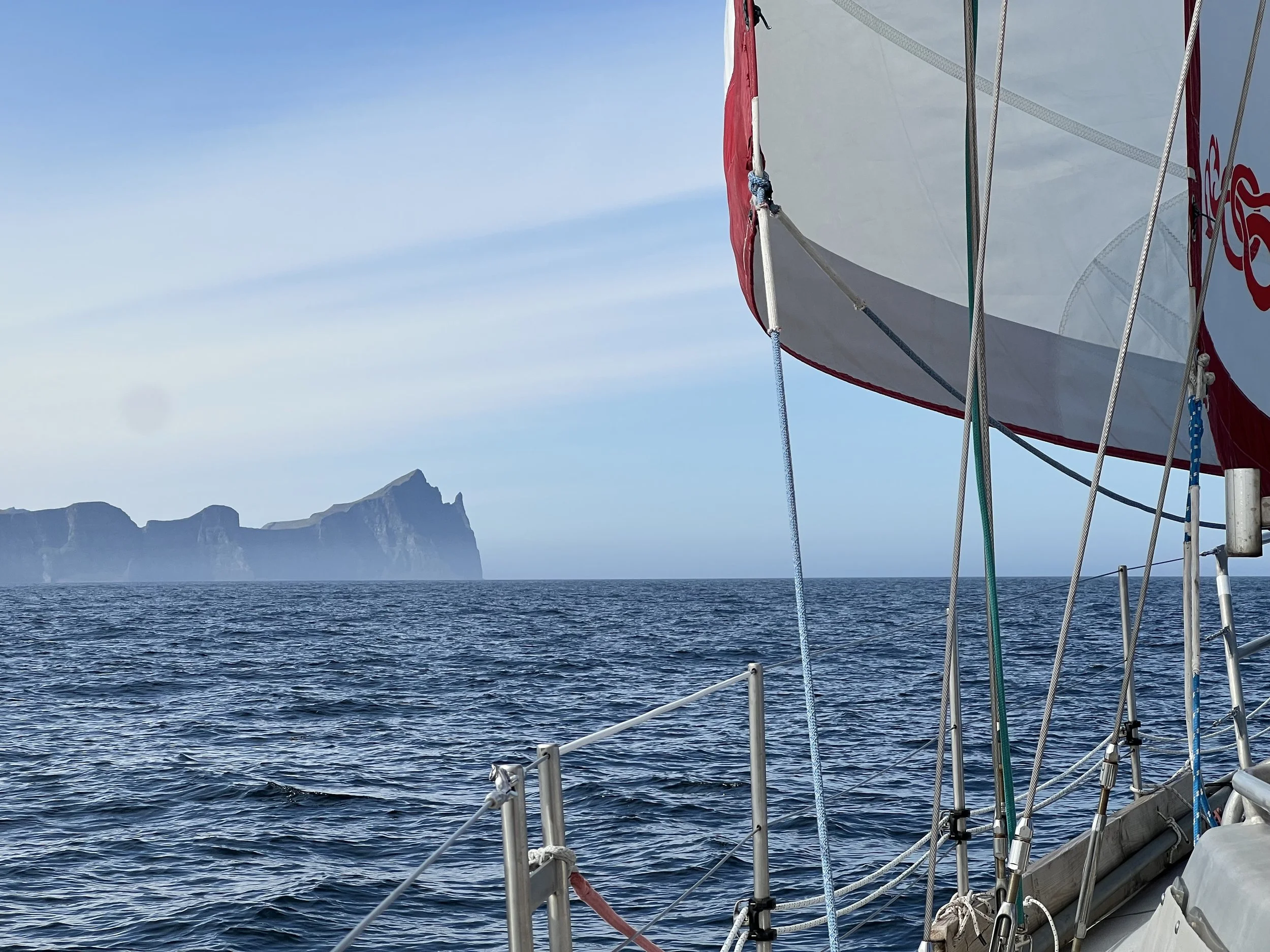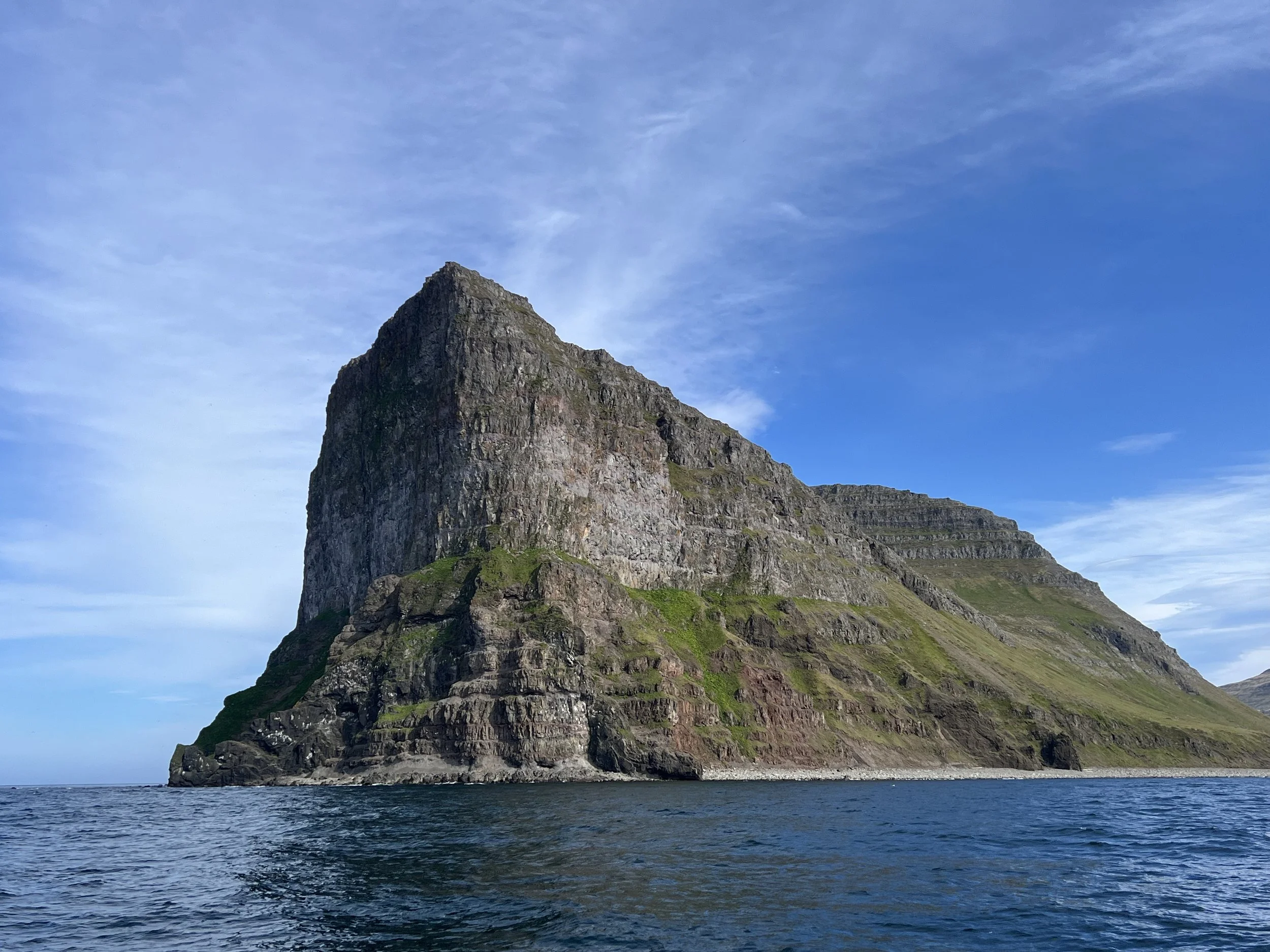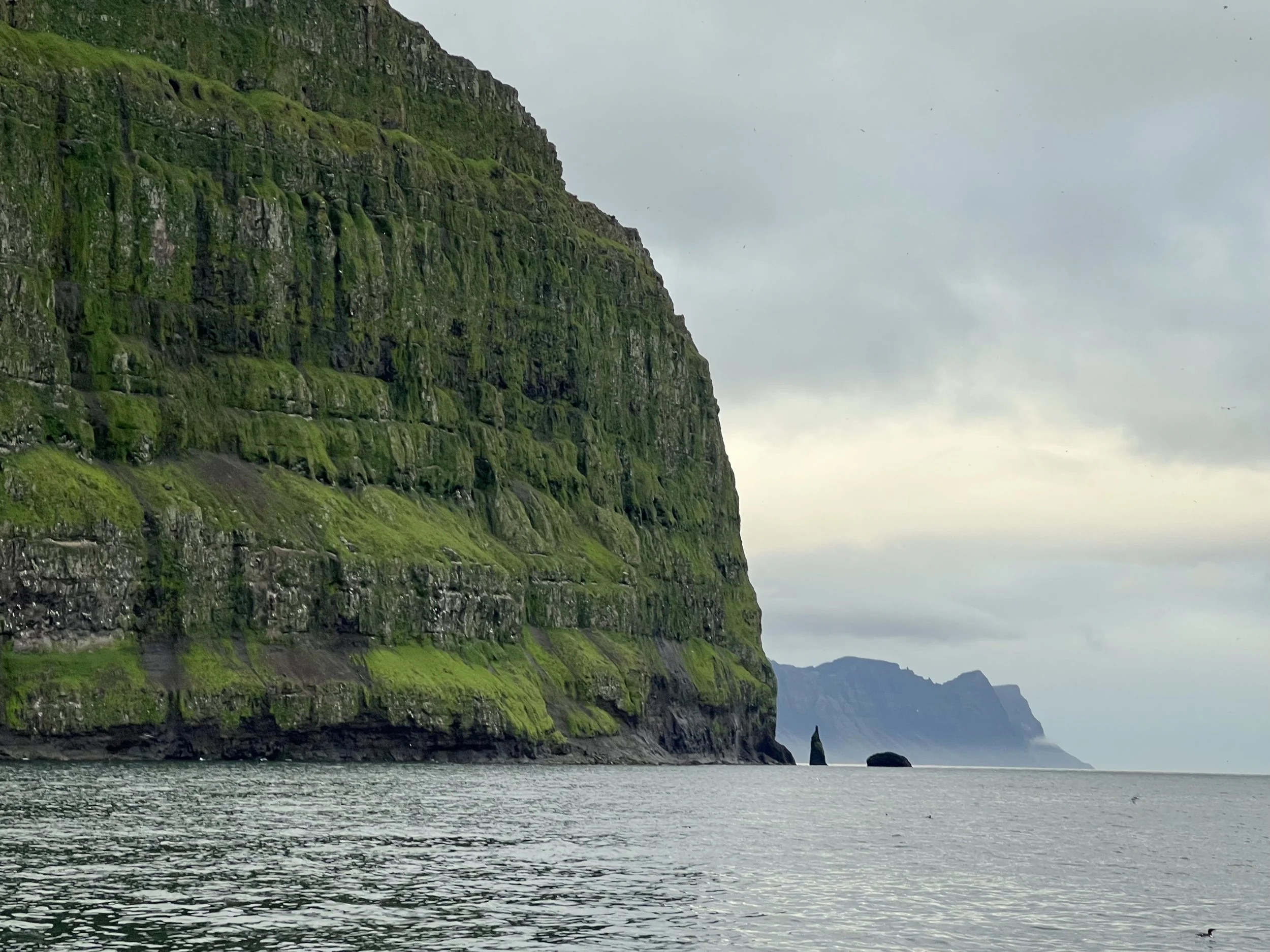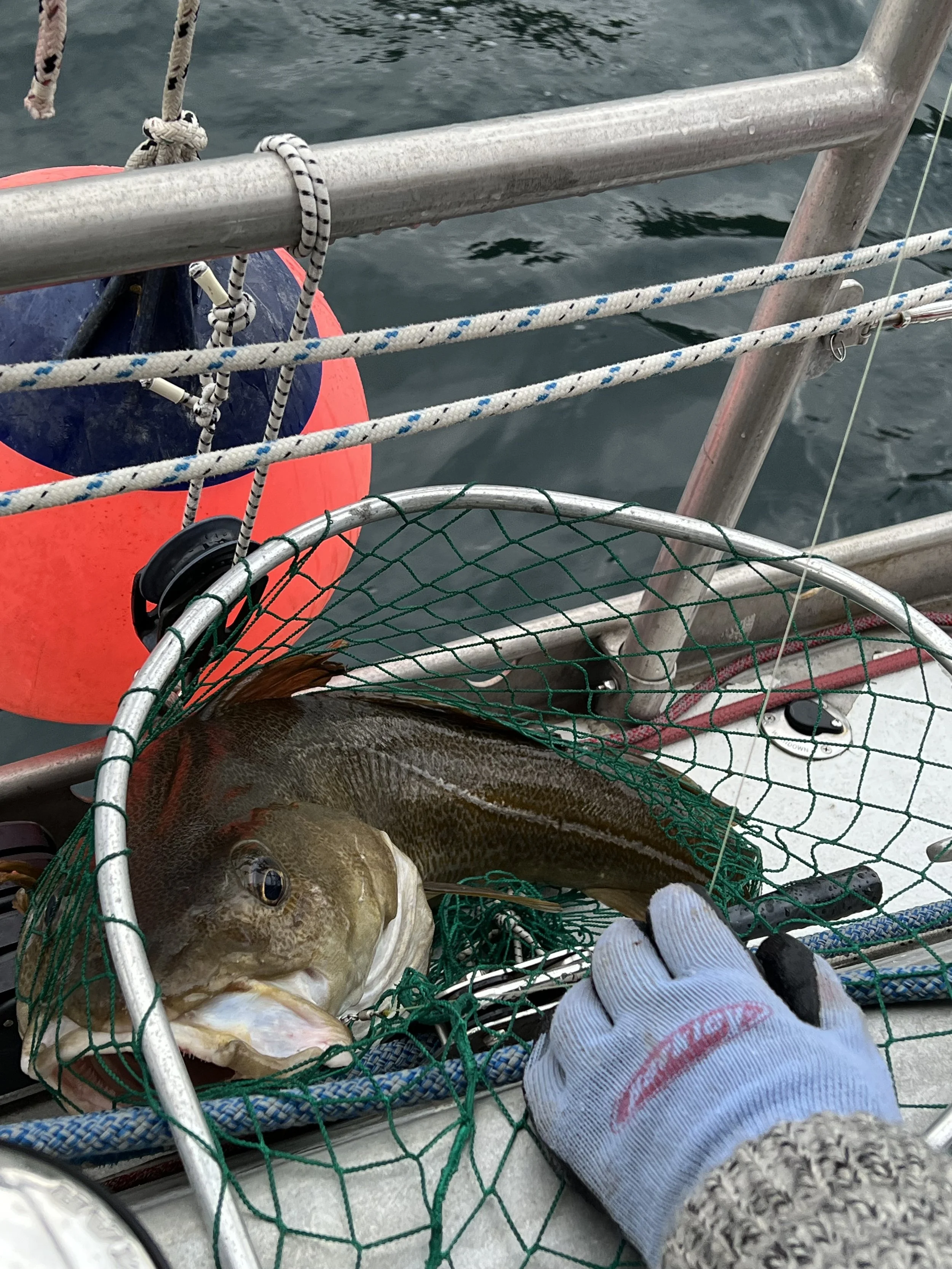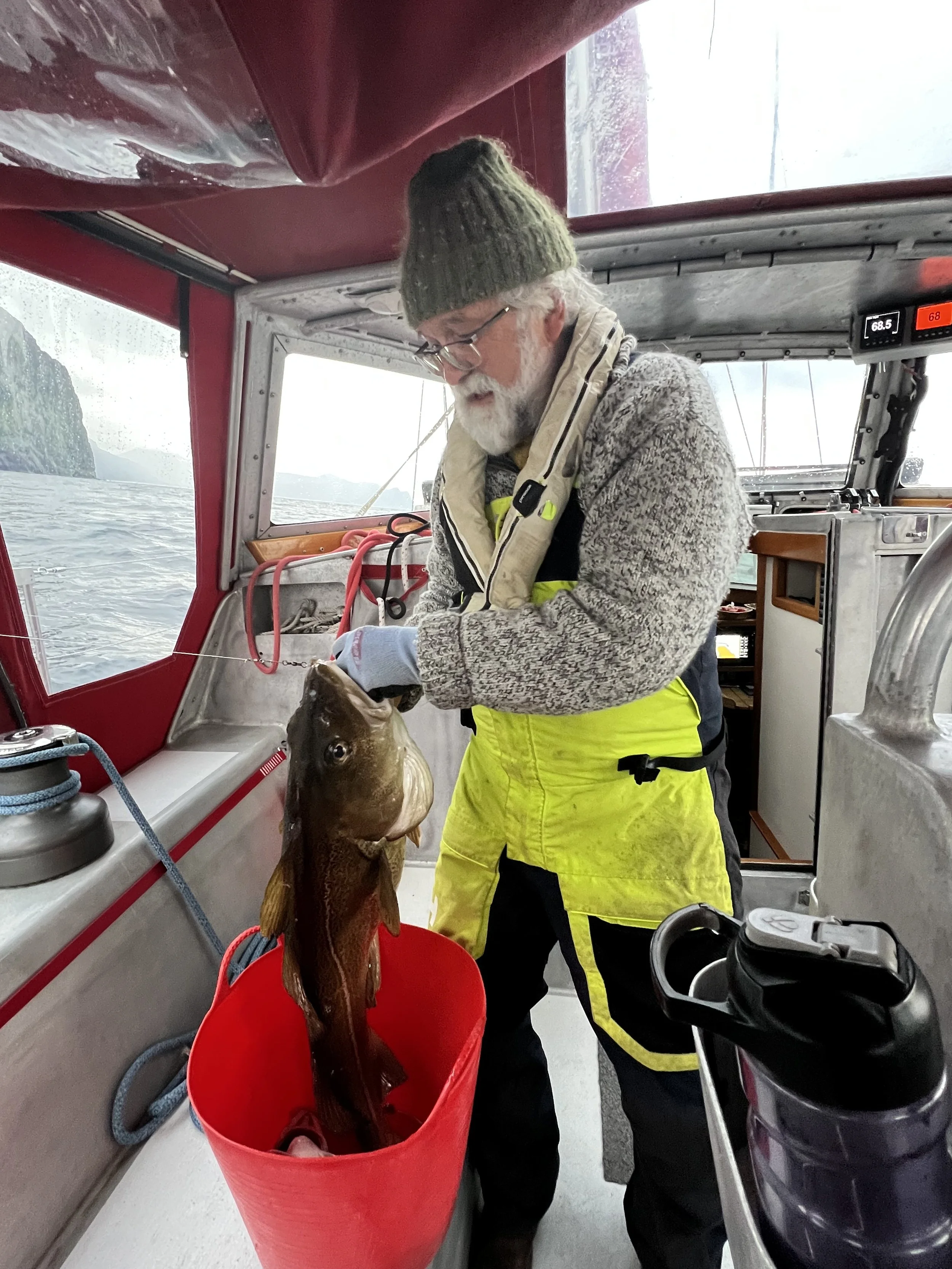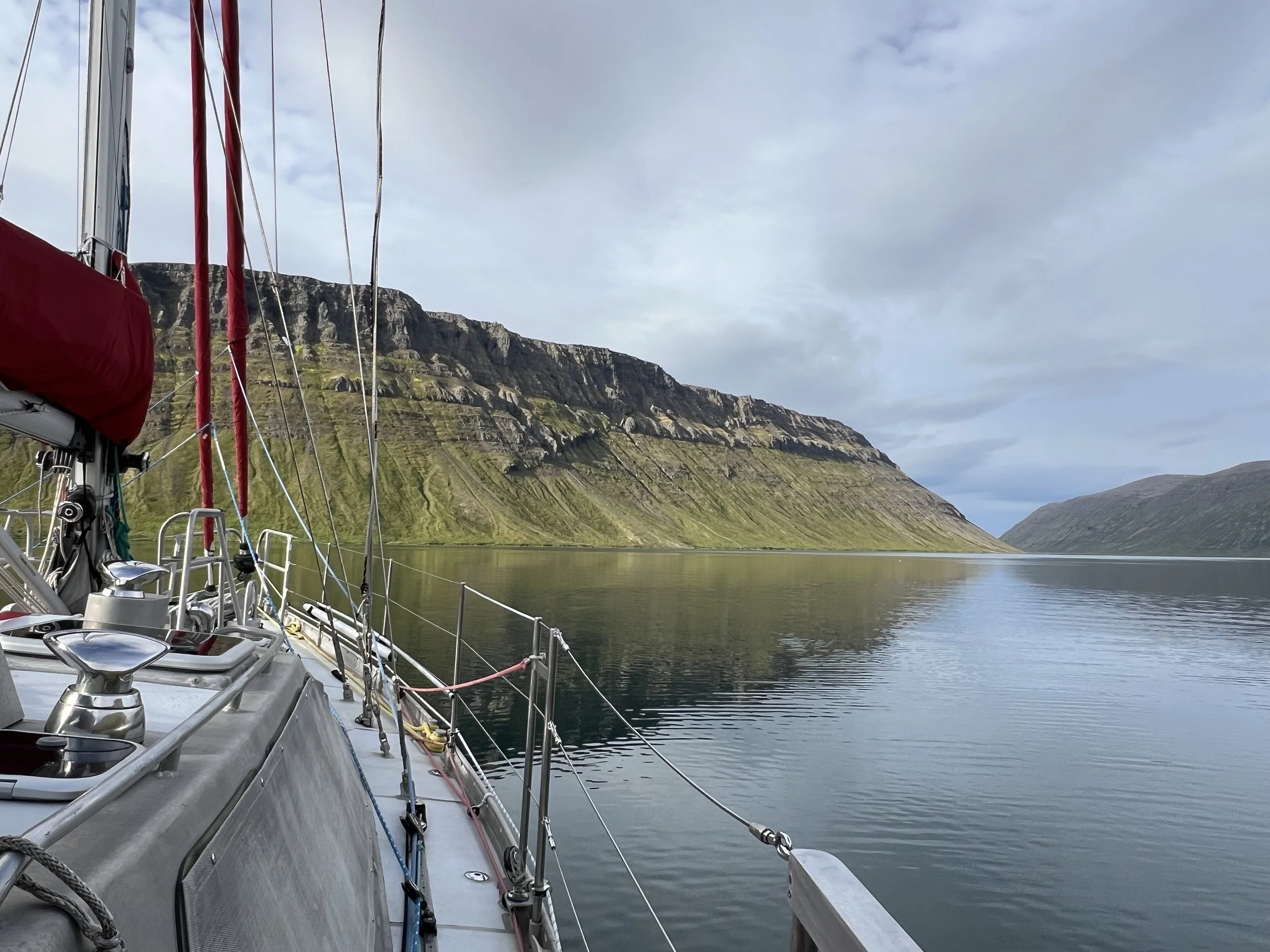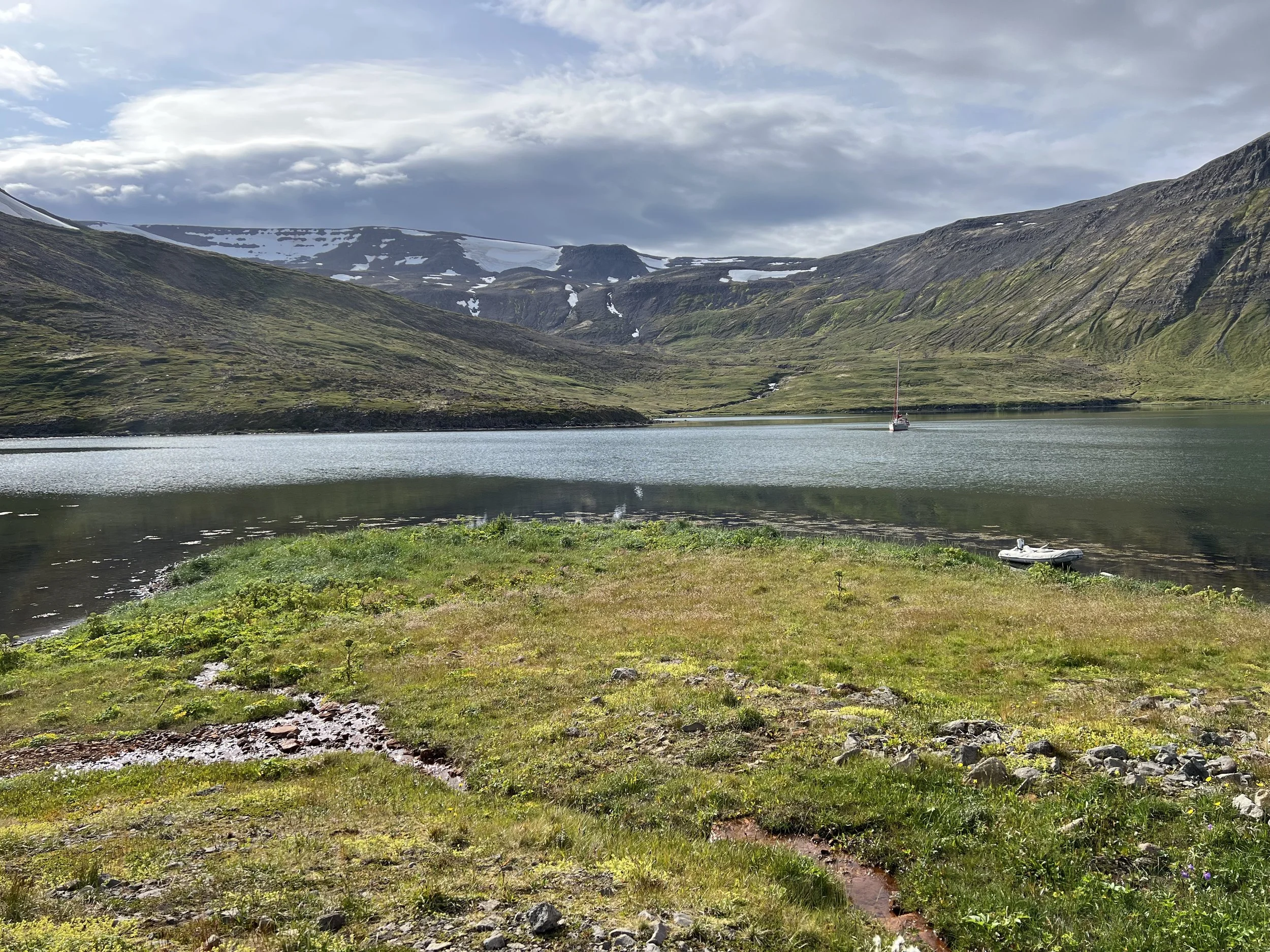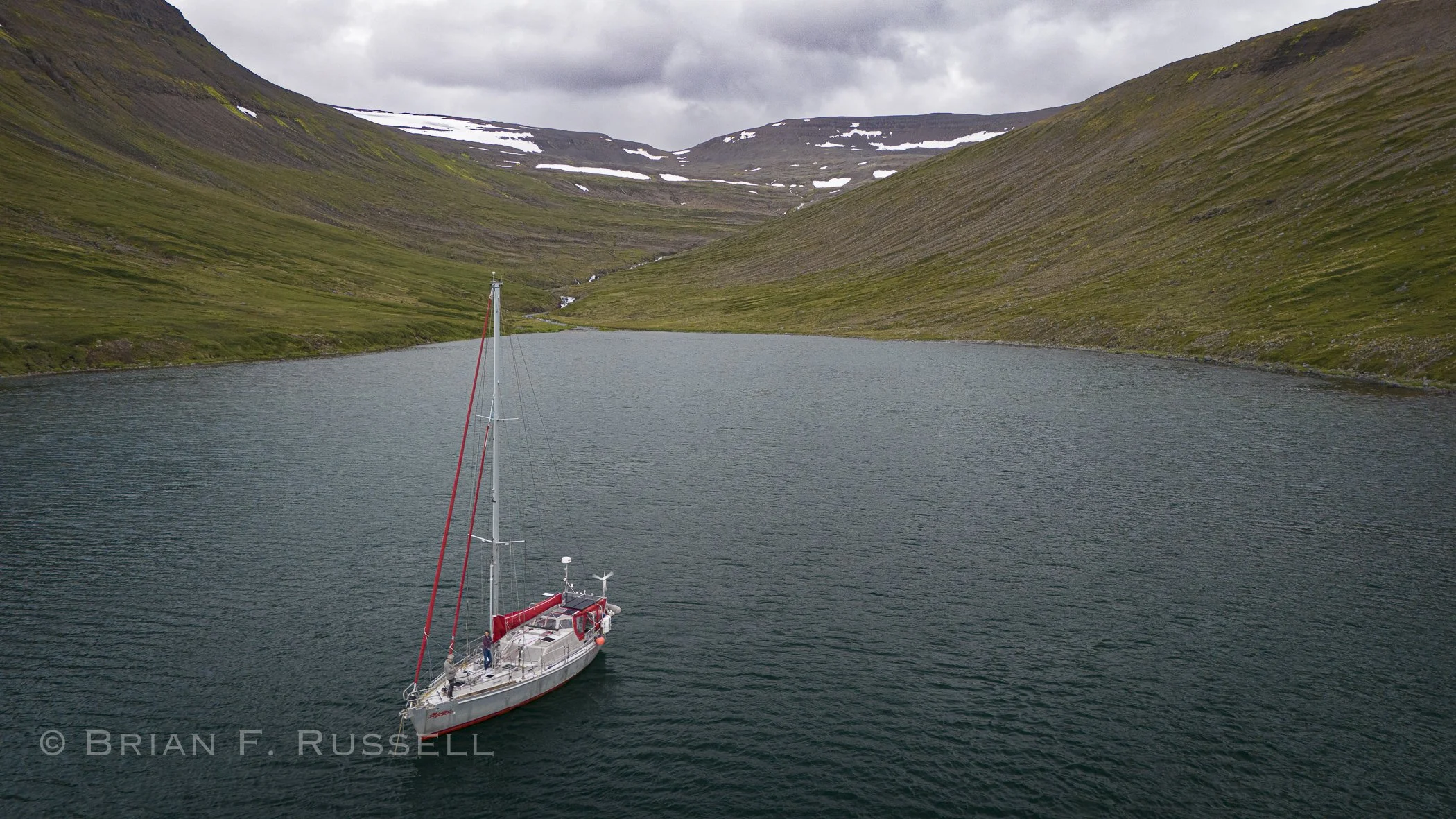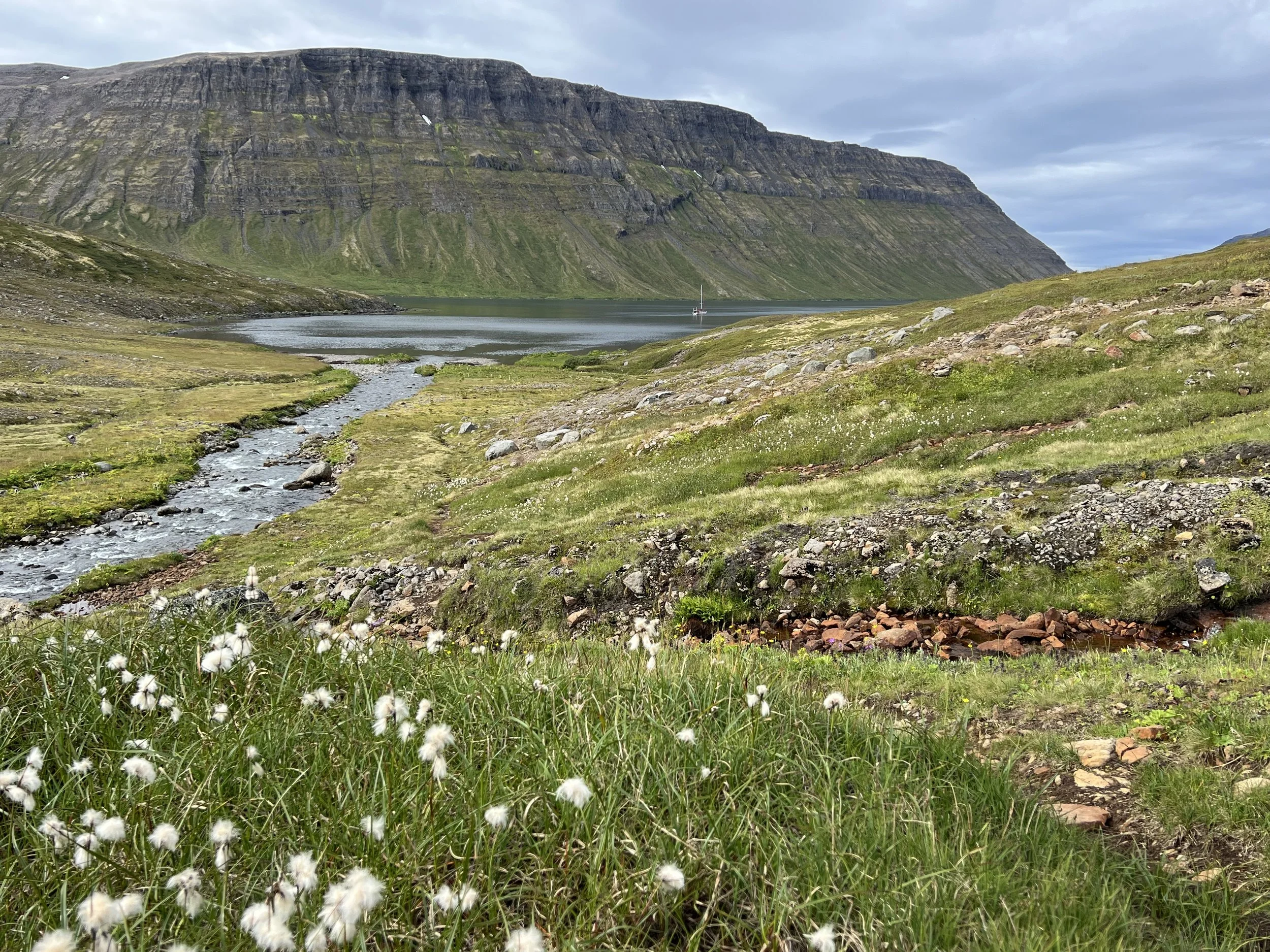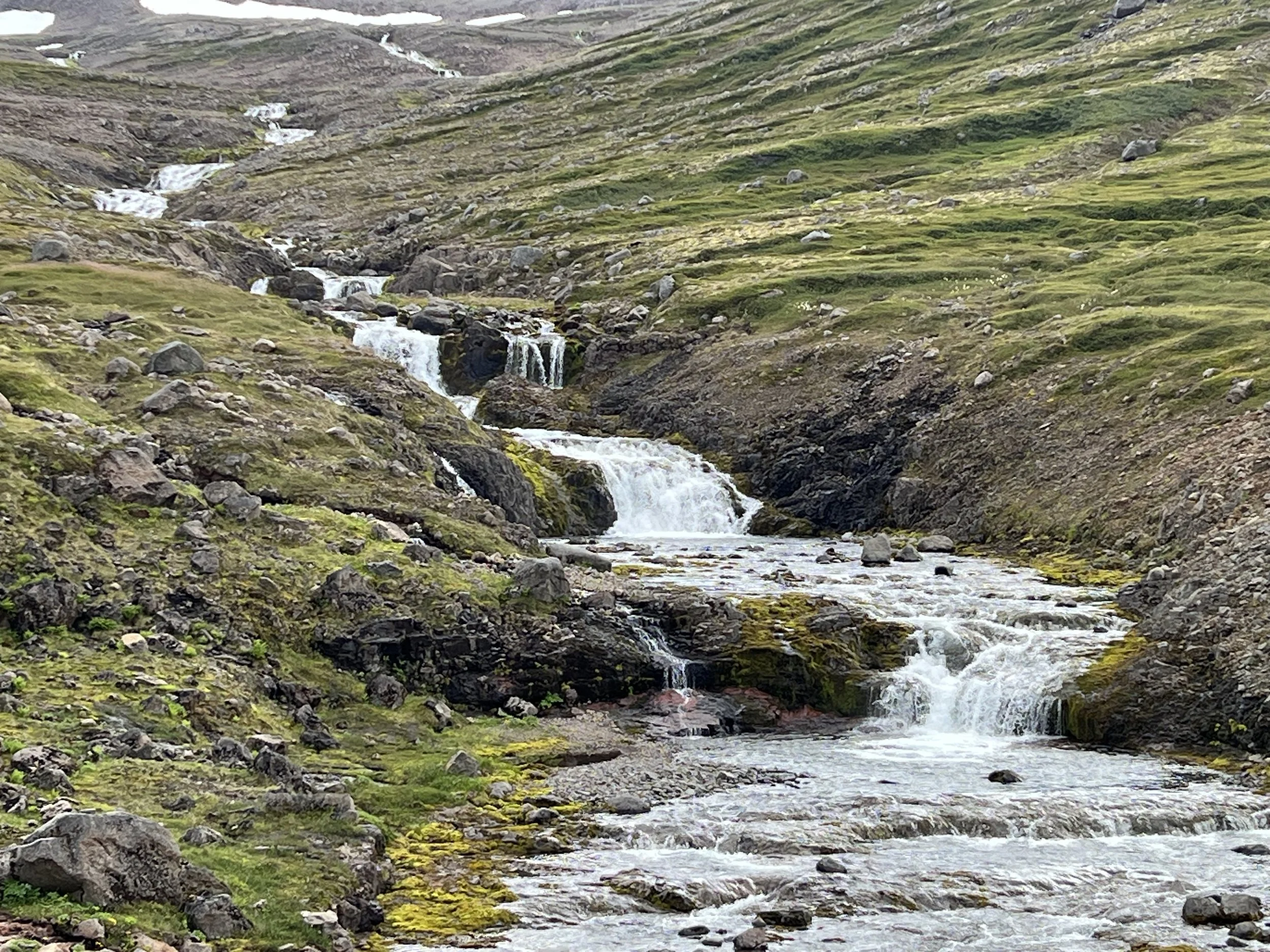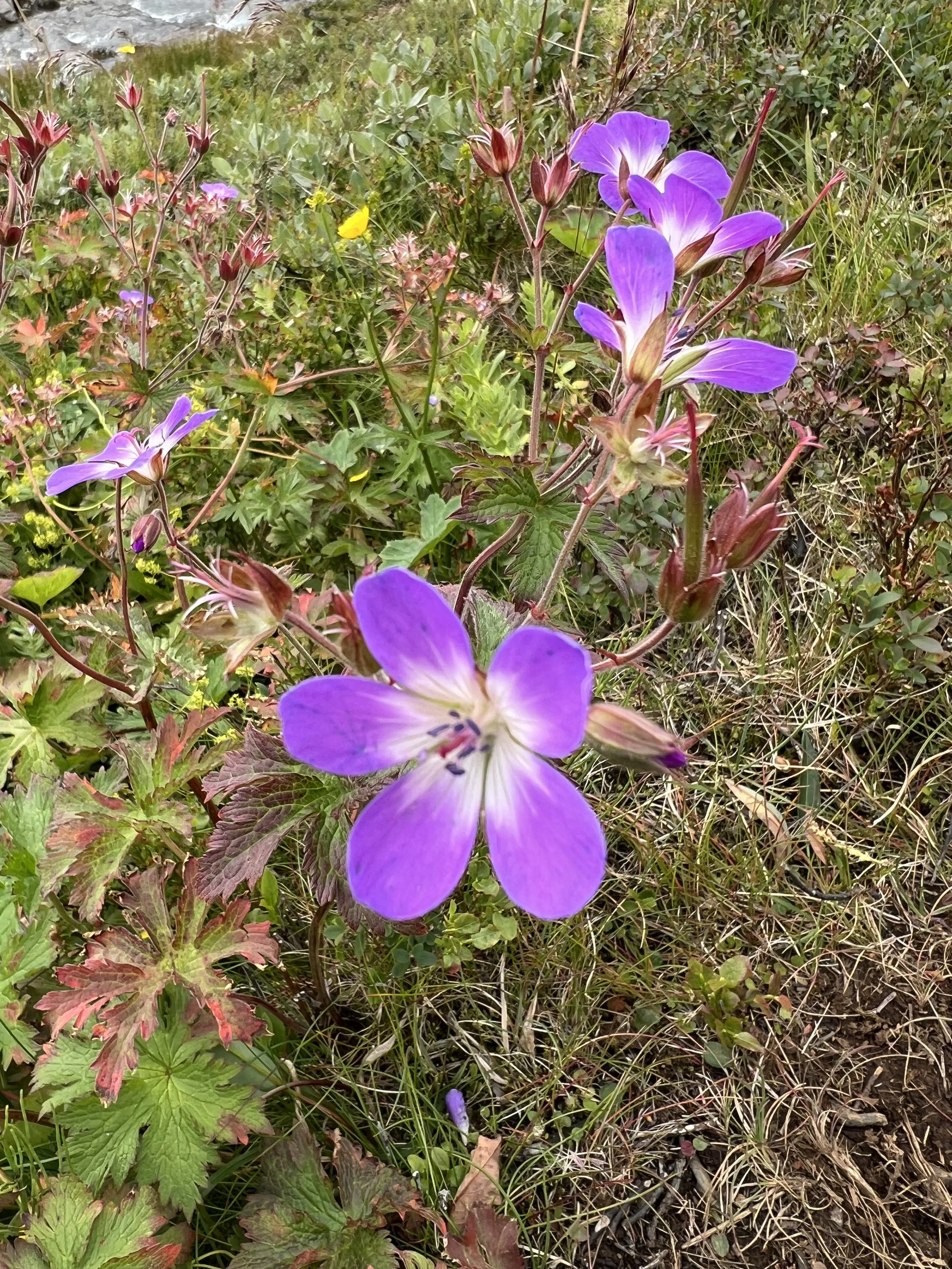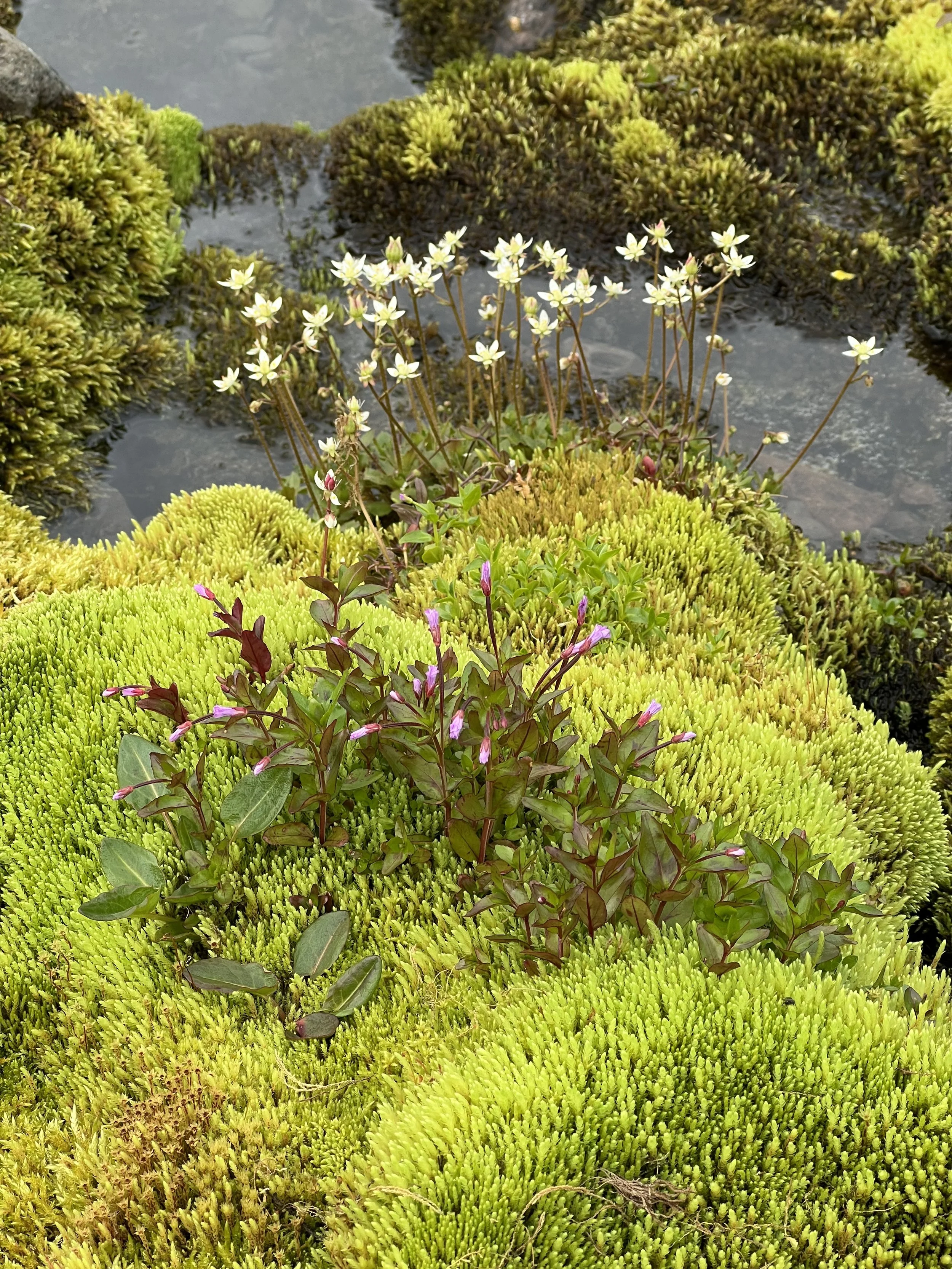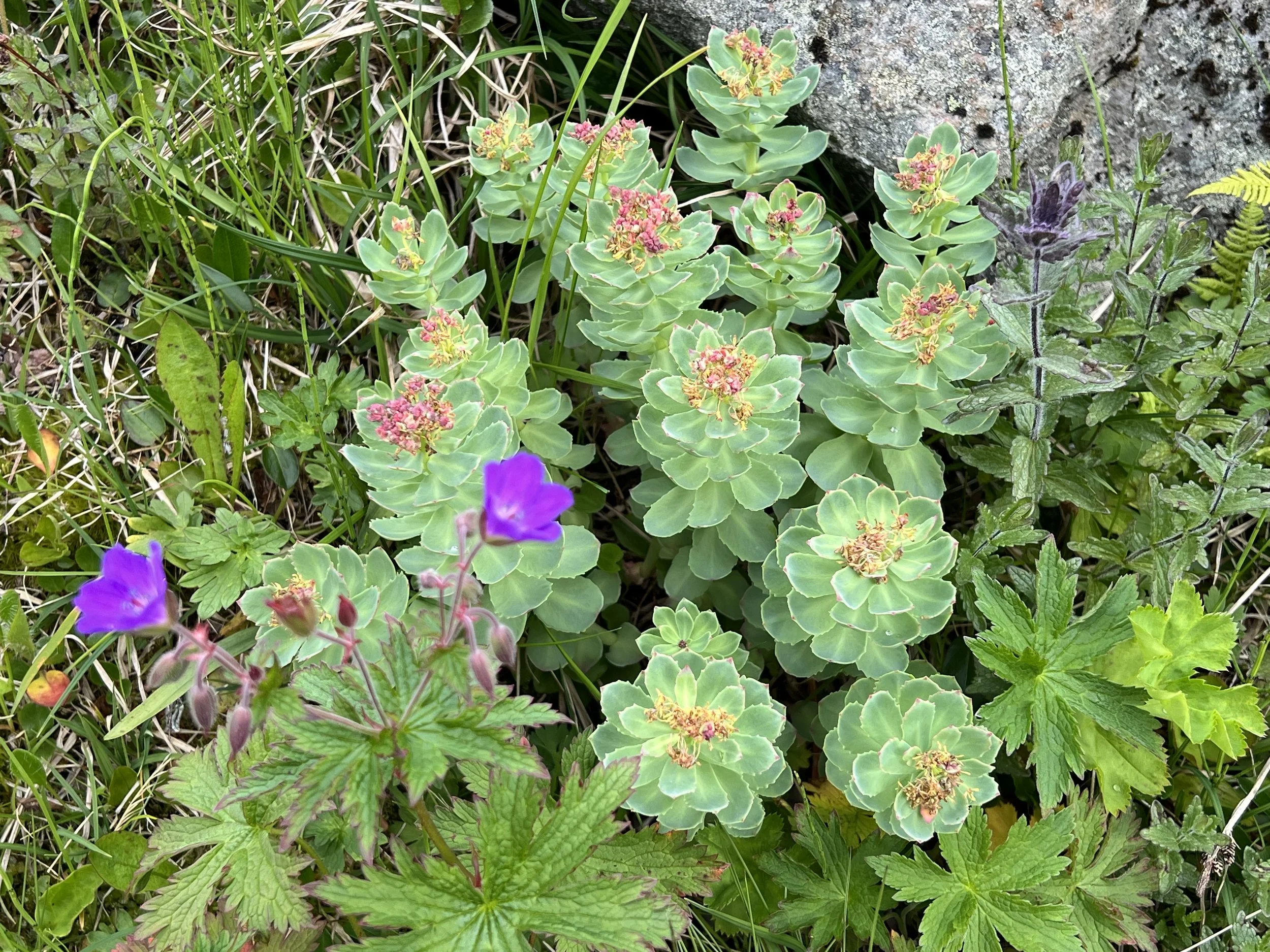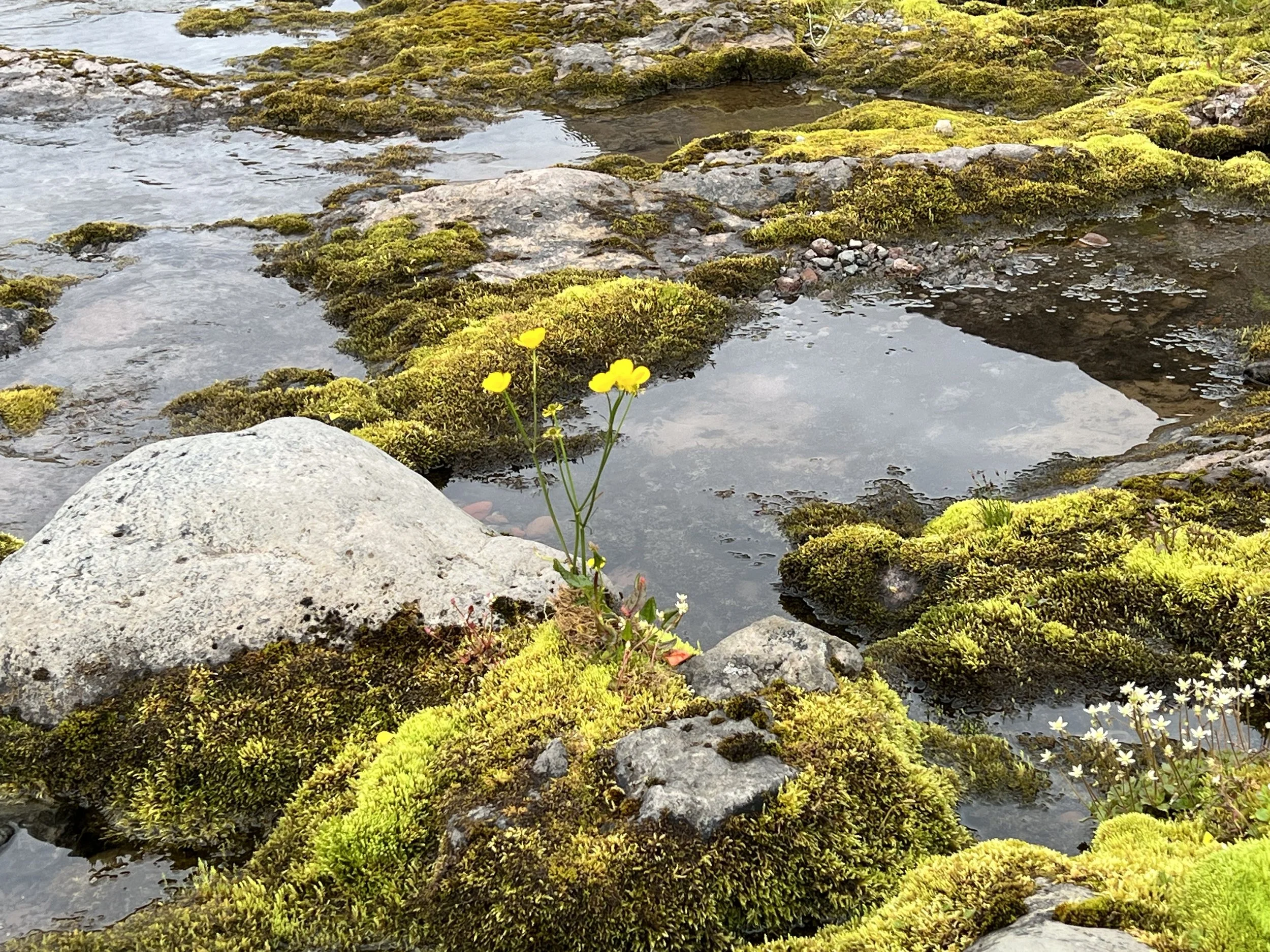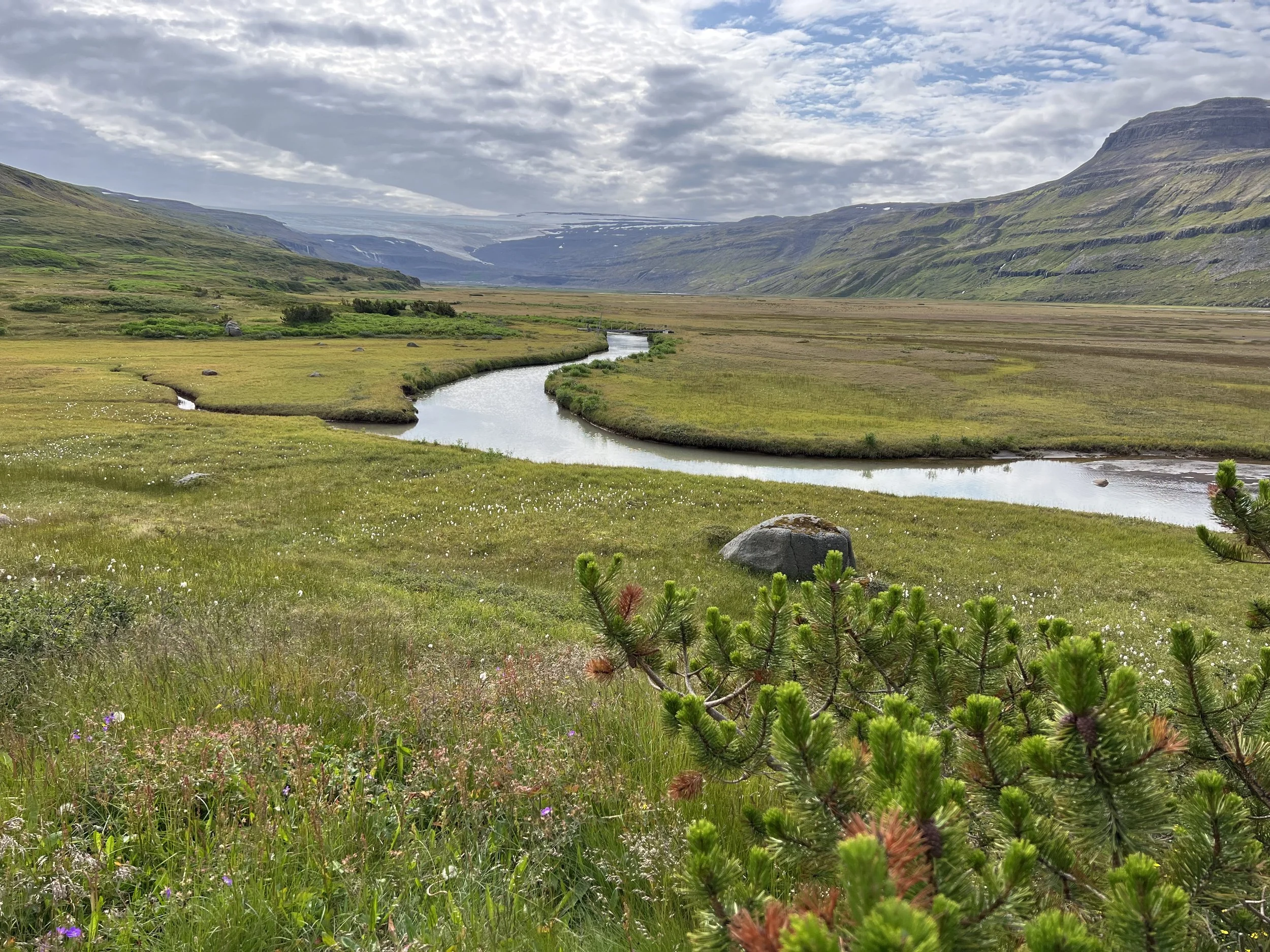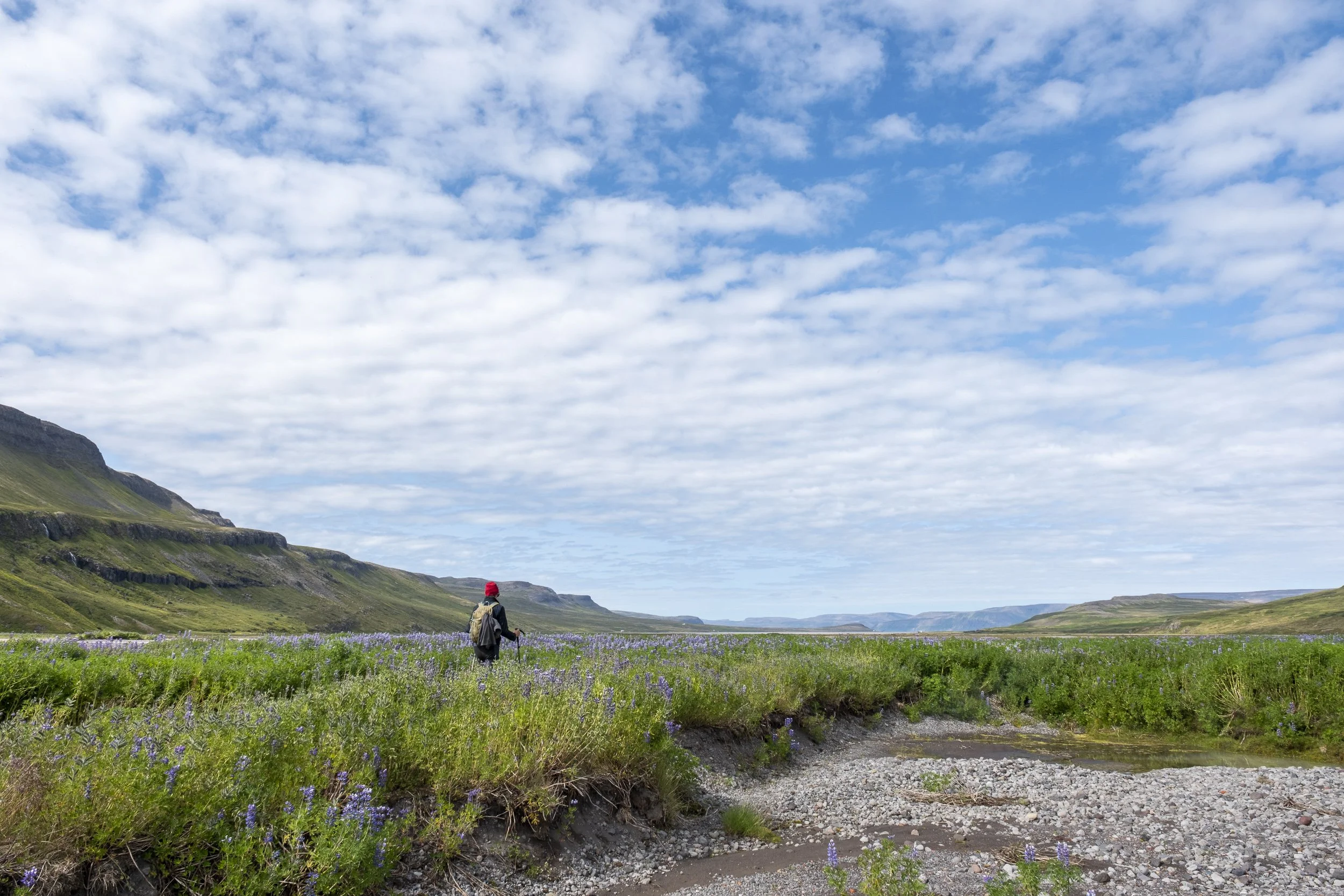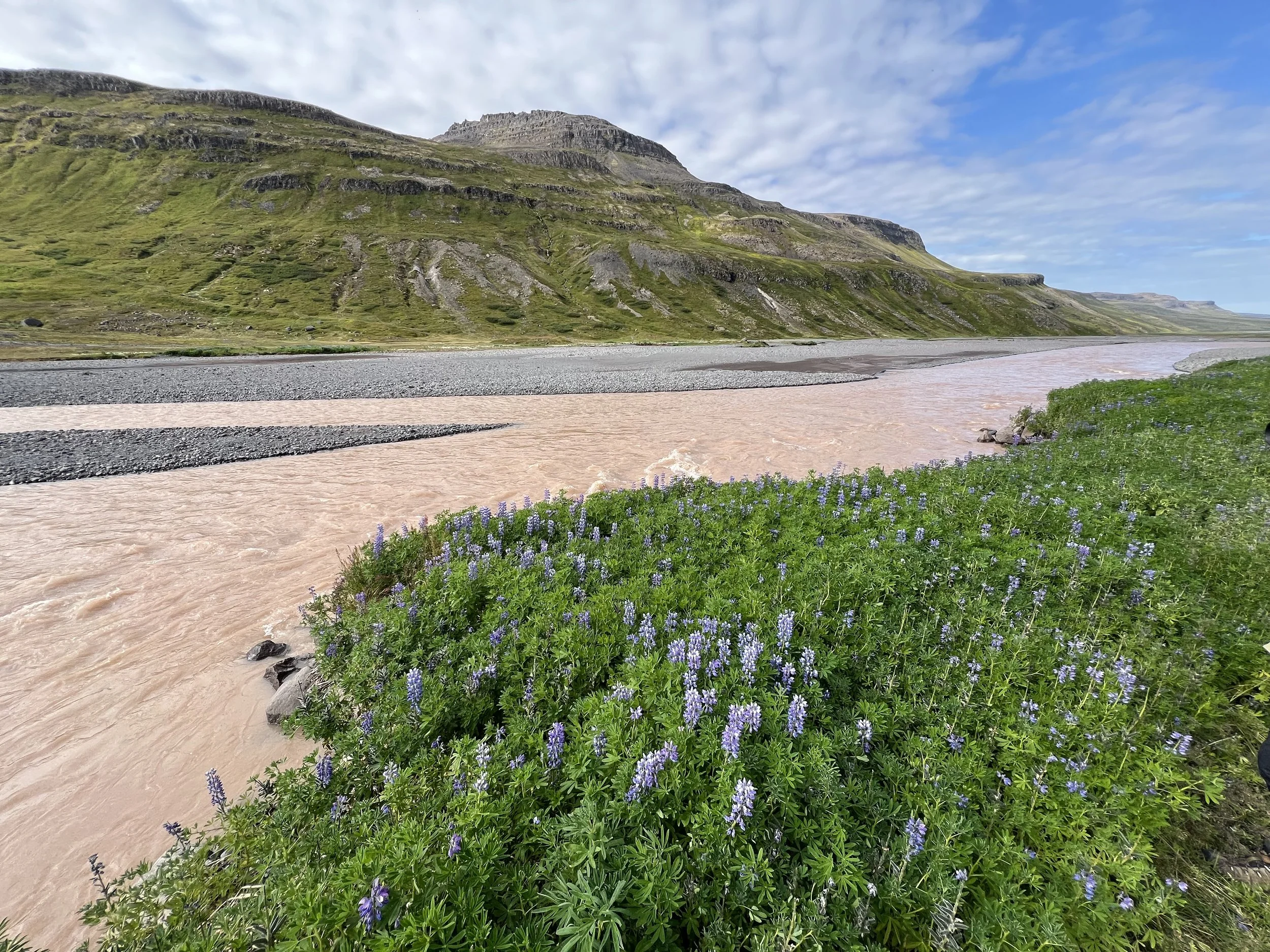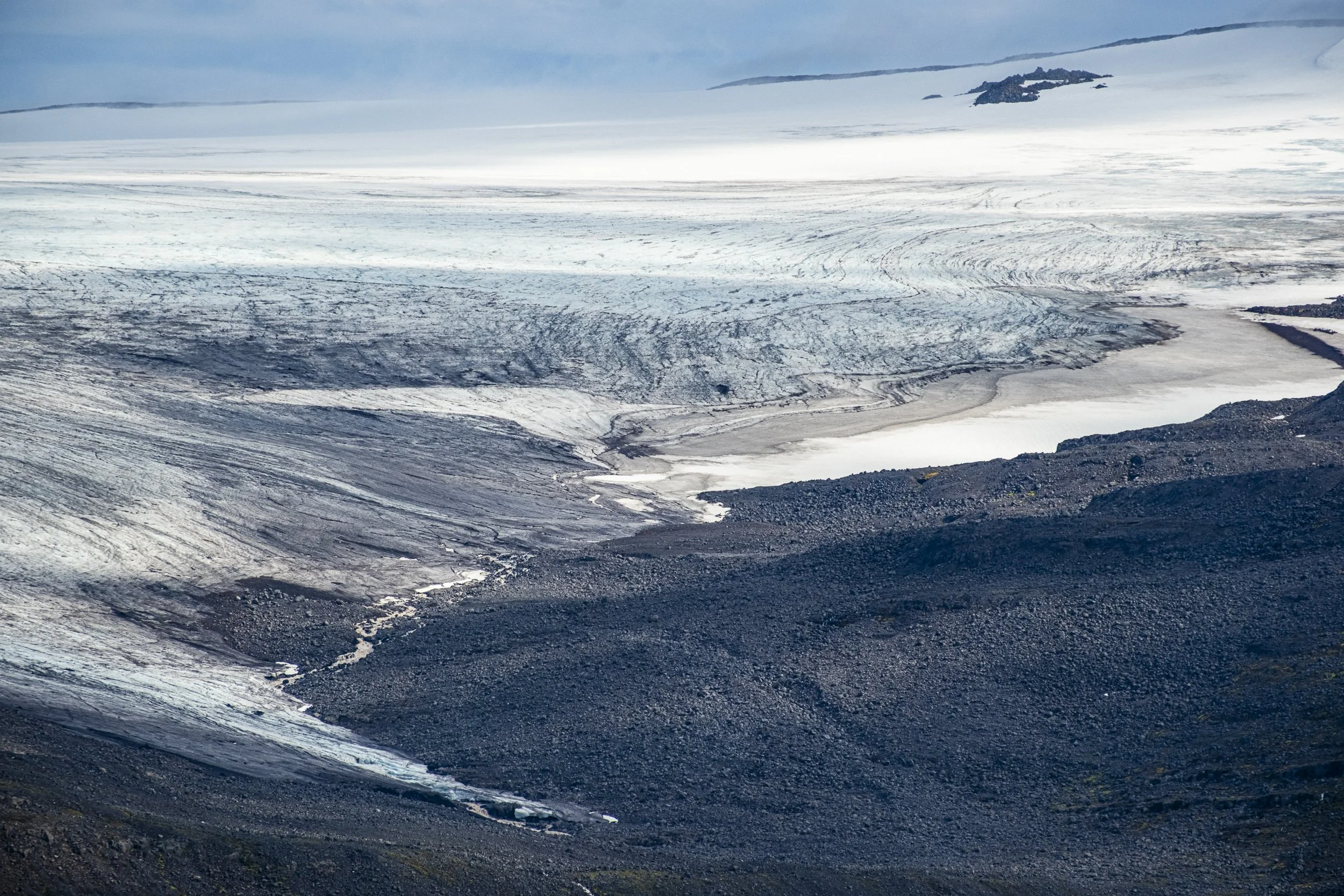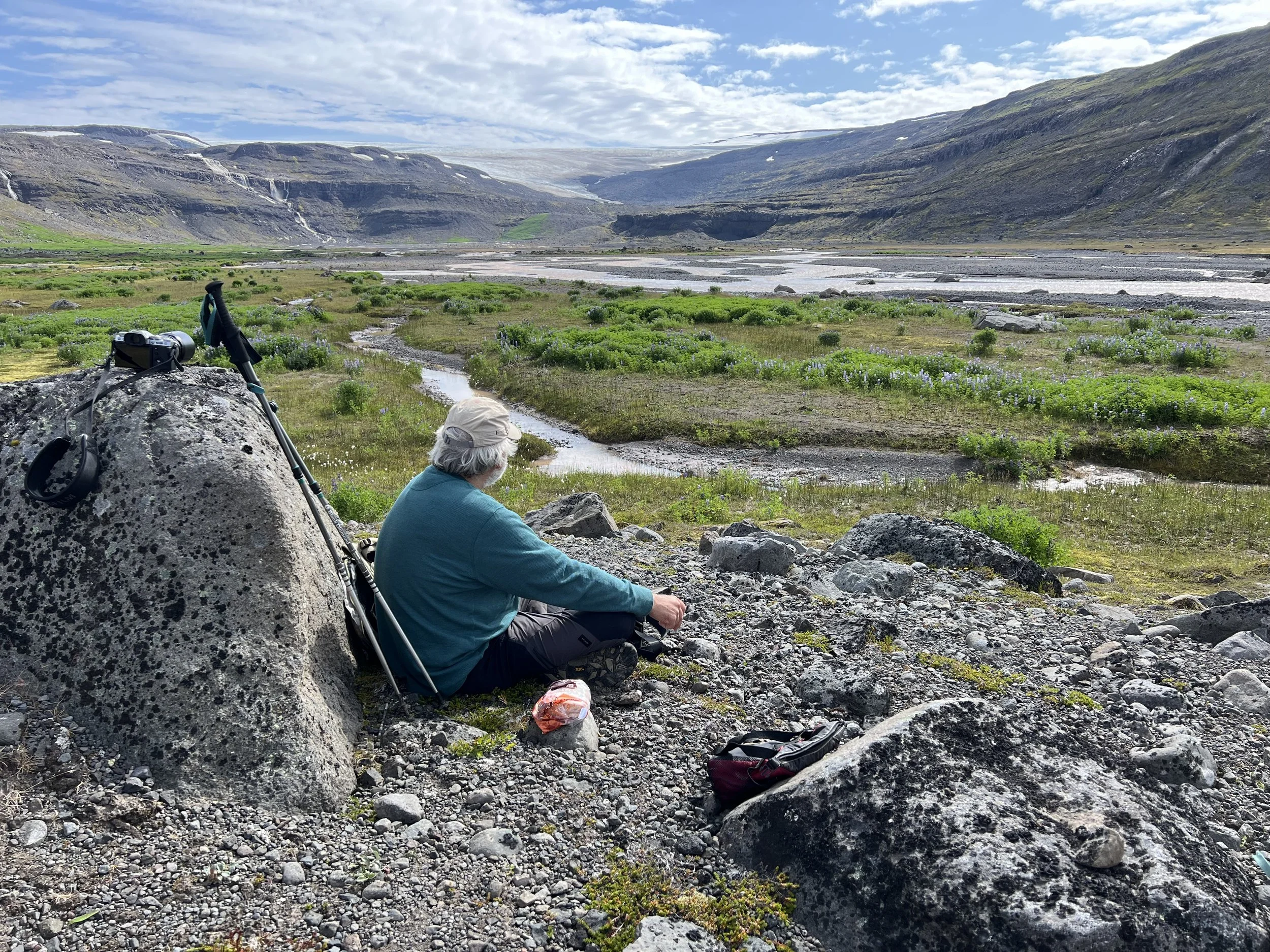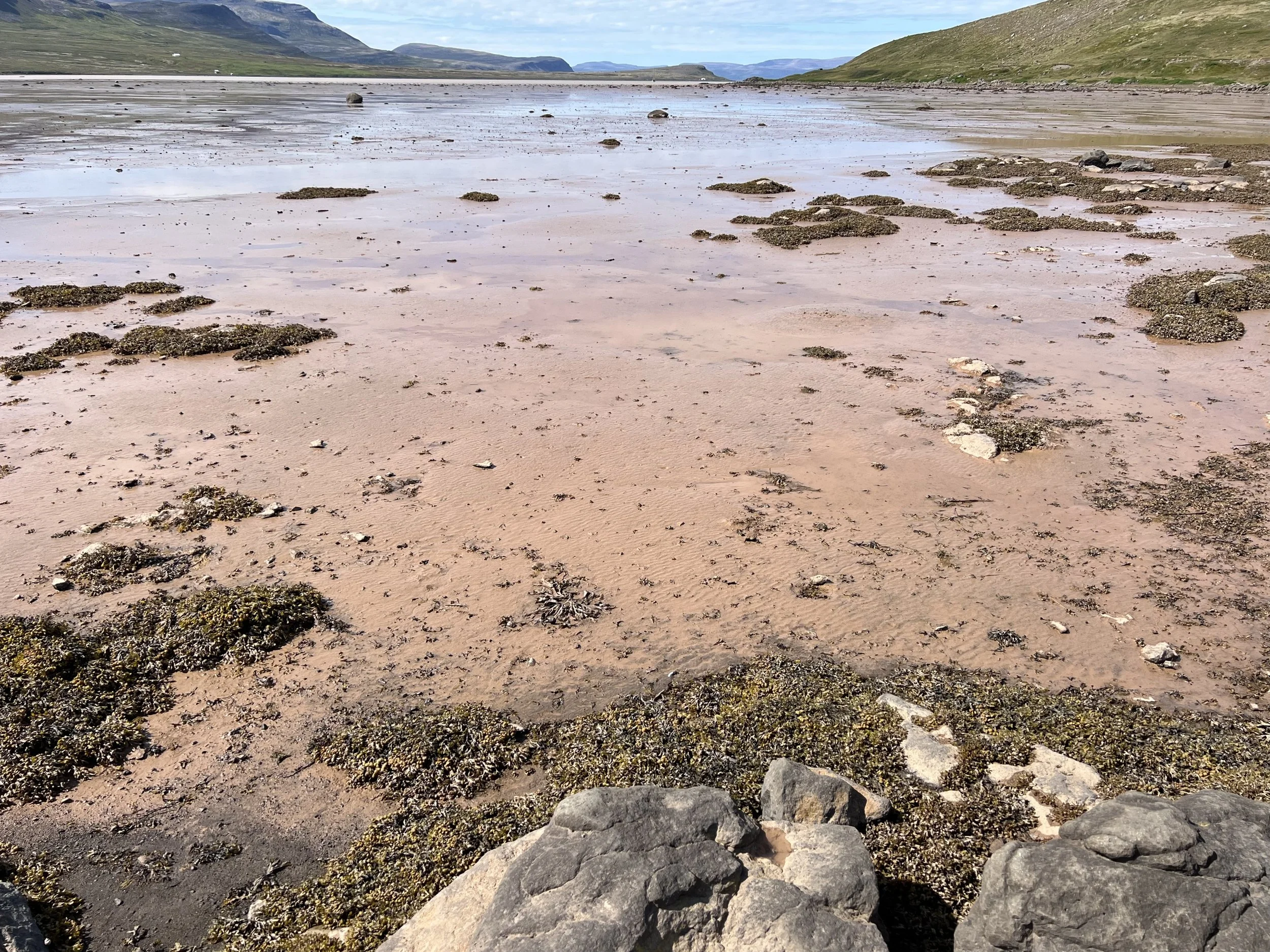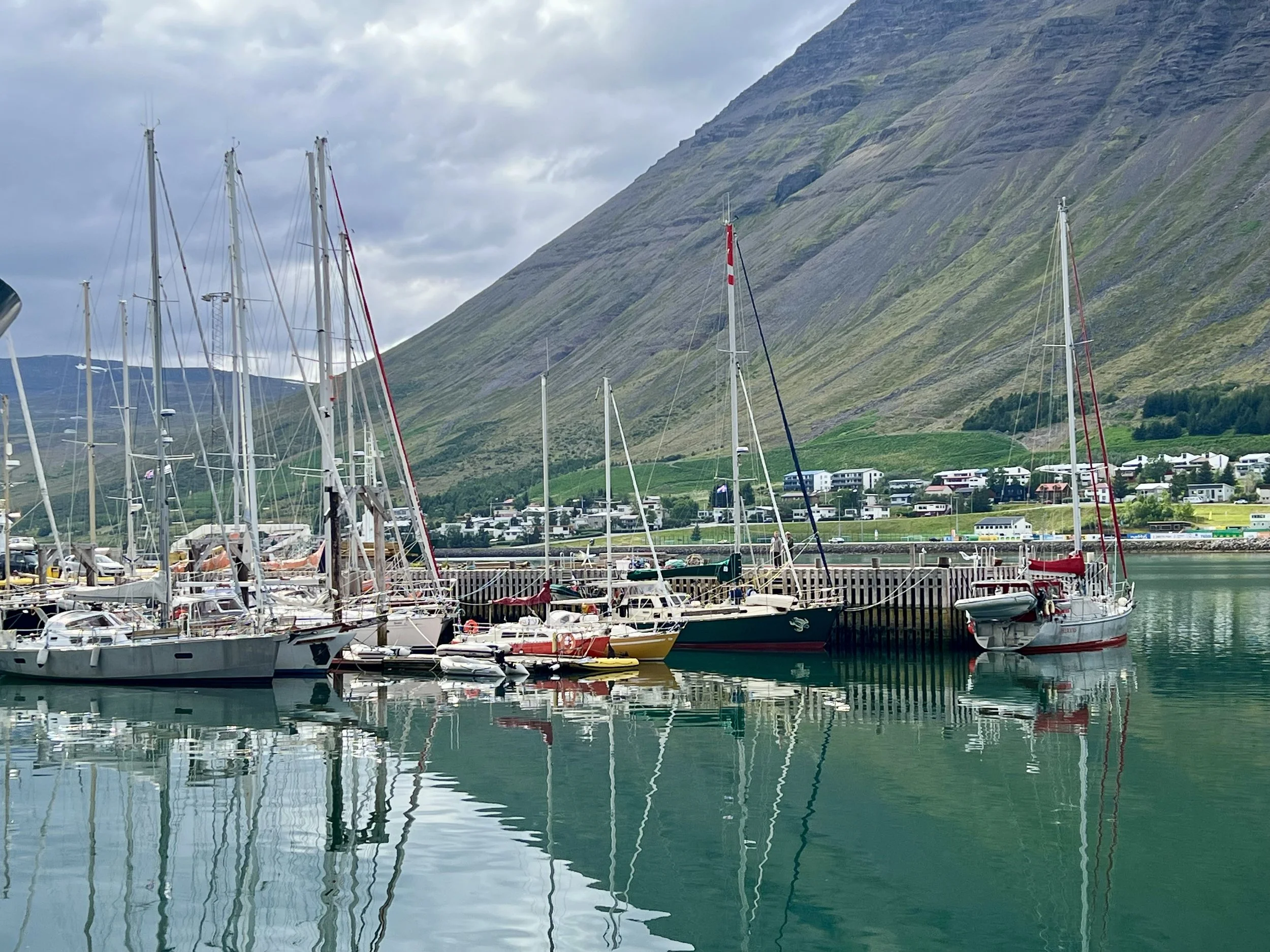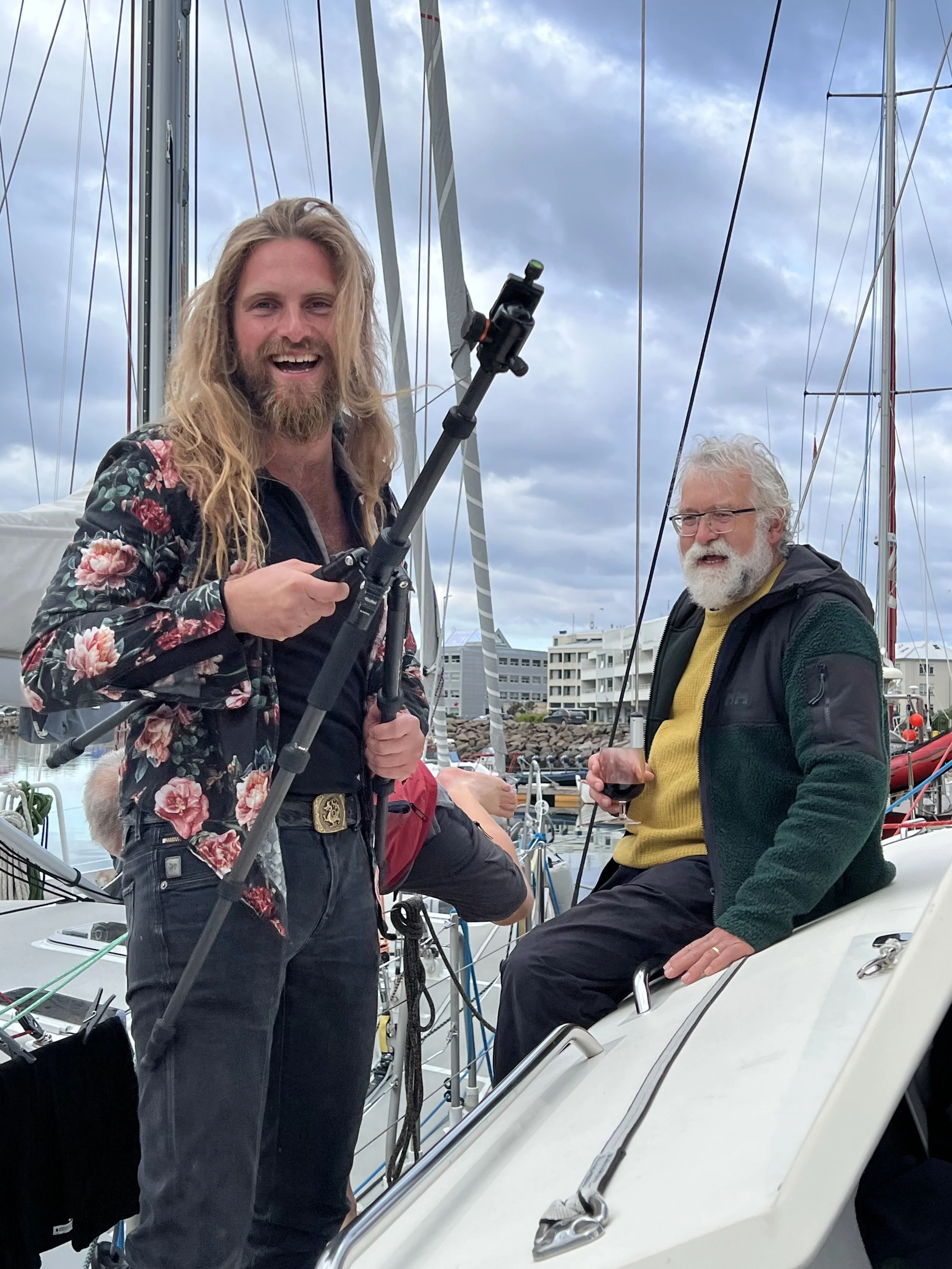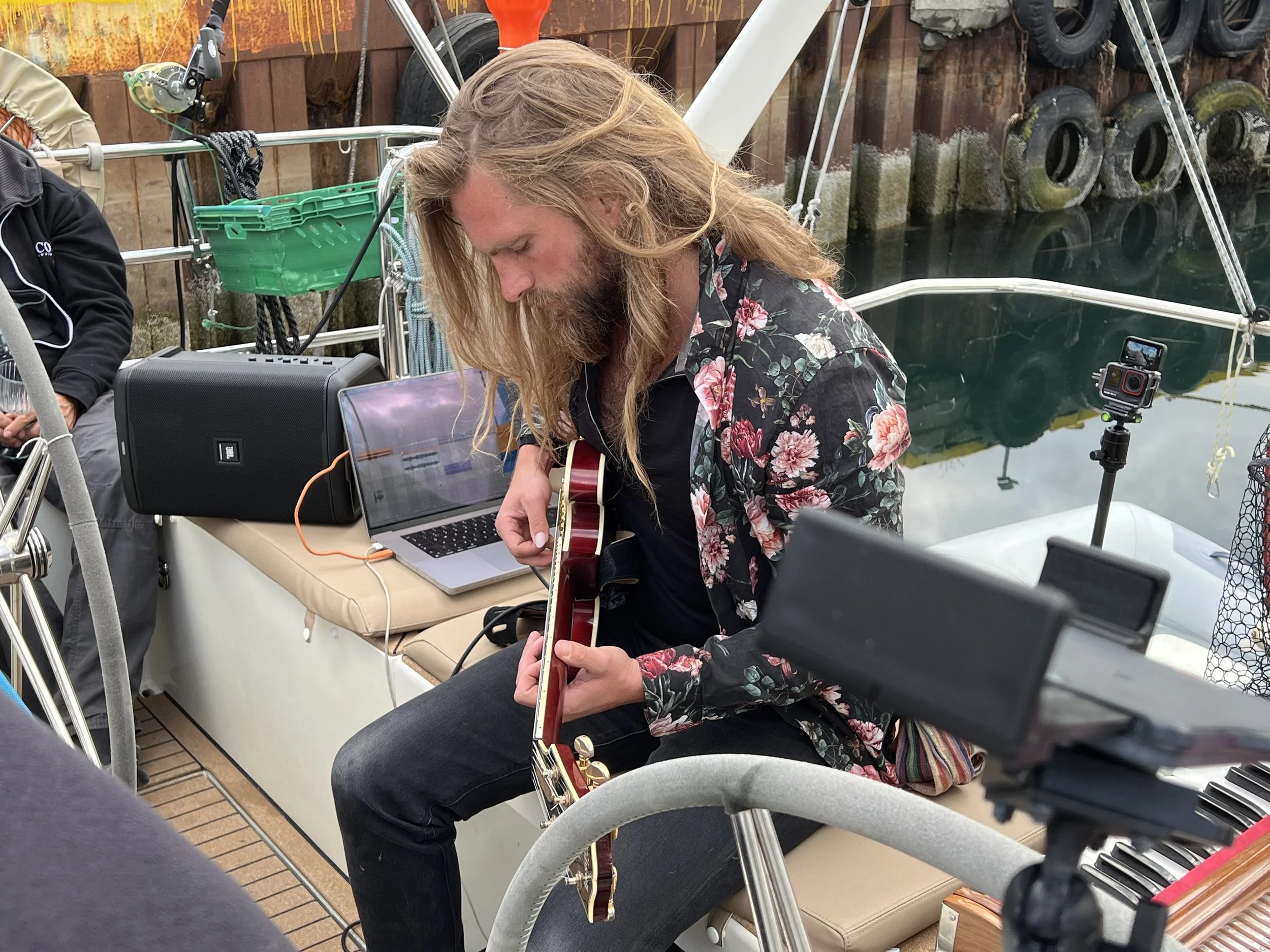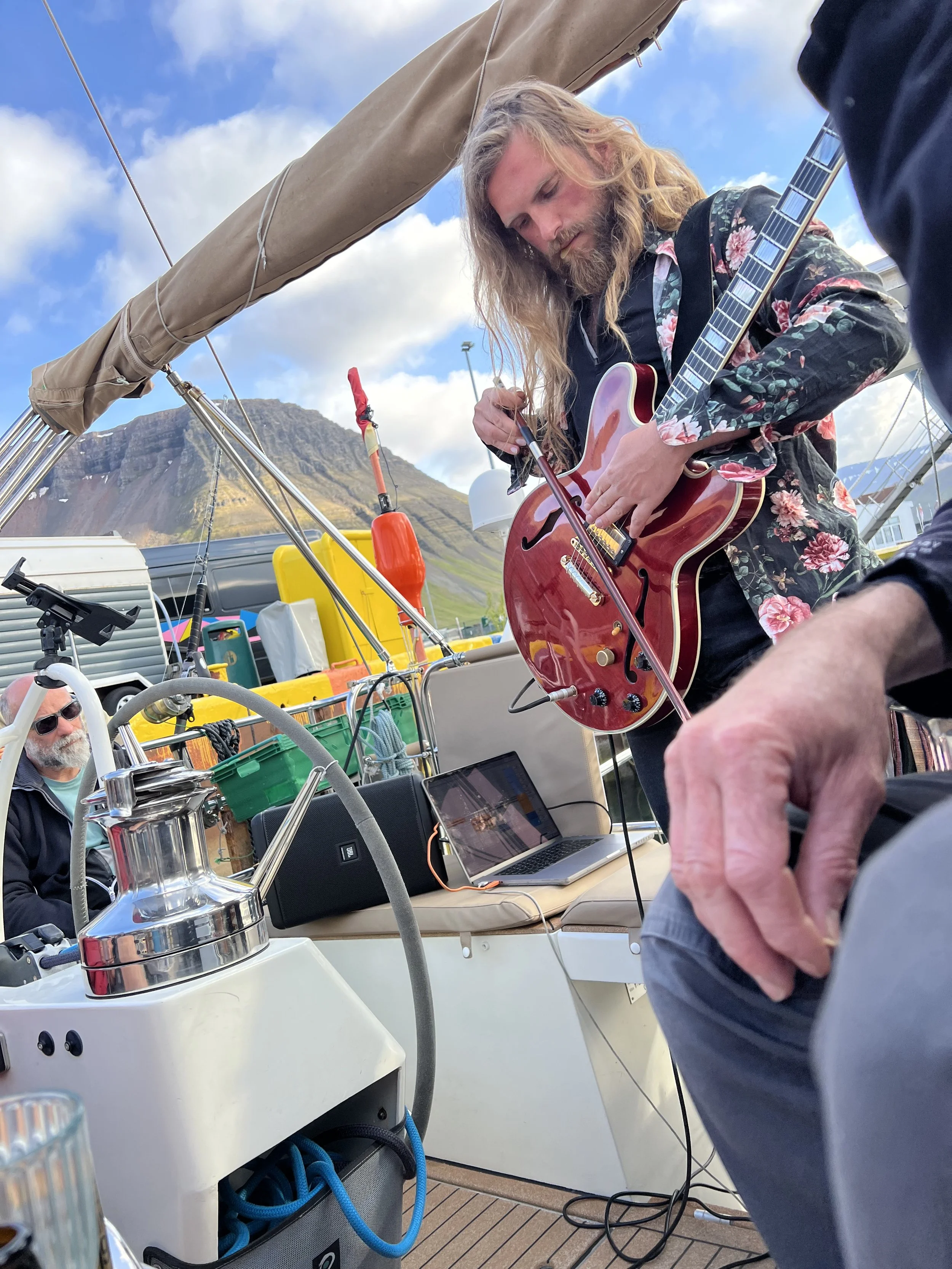Over the top of Iceland.
Helen, on top of the world.
Moving on we start the sail along the northern Icelandic coast. The first stop is Husavik. The afternoon turns to evening and the sun lingers in the sky to past midnight.
Approaching Husavik in the late evening light.
As we pass over a shallow area Brian drops his line in the water and within 15 minutes we have 3 good sized cod in the bucket.
Húsavik is a good stop for us. We catch up with Mike and Helen on Pangey, (thanks Helen for the lovely rhubarb). We stock up on groceries and get some laundry done at the local campground. Husavik used to have a thriving herring industry, but after the collapse of the fisheries it became a popular tourist stop and is now more famous for whale watching. We see the boats heading out, hopeful guests dressed in colorful foul weather gear gathered on deck. The following day we get our whale identification sheet out and follow the tour boats.
After a while we leave the whale watchers and actually have better luck ourselves as we head out of the fjord. We see some minke whales and many puffins, too. Iceland used to actively hunt whales, predominantly the minke whale, but it is considerably reduced in recent years. Modern sensibilities for the win.
Minke whale and puffins.
Our next harbor is on the southern tip of a small island in the center of Eyjafjörður. Hrisey has been designated as a bird sanctuary and is a major nesting ground for Ptarmigan. Tractors are the preferred mode of transport, and there were some fine antique samples.
The gentle rolling landscape made a nice contrast to the rugged snow covered peaks all around. The trail we followed was lovely and we saw many birds; Ptarmigan, Golden Plover and Whimbrel.
Drying racks for cod, not used in quite a while.
A couple of days later we have a light wind forecast, suitable for us to head west. As we round the northern tip of Hrisey we notice some small jetskis bobbing around. Upon closer inspection we see they are following a pod of feeding whales. We immediately turn to check it out.
What an experience! There were at least a couple of pods, the one we followed had about four humpback whales, slowly working their way along, diving and surfacing as they browsed on the schools of fish somewhere beneath. A raft of seagulls followed them, ready to pick up any scraps.
The weather was perfect for a gentle and slow sail all the way over to the western cape. We arrive at about 3am and anchor in the large, but sheltered bay of Trékillisvik.
The small harbor was 3 deep in small fishing boats, no room for a big boat like Helacious. We take the dinghy in and tie up. Chatting to a fishing boat that had just come in we find out they are seasonal fishermen, getting a permit for the summer to fish for cod, maximum catch 700kg in a 24 hour period. They have to have it back to the marina for pick up by the refrigerated truck that then takes it to Reykjavik. We had seen a stream of boats leaving at 3am as we had arrived, that was why.
That afternoon we make our way around the peninsula to the geo-thermal pool on the waters edge. We meet our fishermen friends again, relaxing after a long day out on the water.
There are many outdoor geo-thermally heated pools throughout Iceland. We had waited until we found one that was less developed and the sun was shining before diving in. It was lovely, 37C main pool and 39C hot tubs.
We stayed in Trékillisvik for a few days, enjoying the walks around the bay, but then it was time to move on.
Heading north we approach the Horn, the distinctive rock formation marking the northern tip, and the wind dies. Instead of motoring the remaining 50 nm, we decide to pop into the large bay just behind the Horn and anchor for the night.
The Horn.
The Horn and Hornvik Bay.
We get up early the next morning hoping to catch the forecasted winds to continue our journey around to the northwestern fjords. Unfortunately they did not get the memo and we still ended up motoring most of the way. Still the disappointment was more than made up for by the magnificent scenery and Brians biggest catch yet, the Daddy of all cod.
Leaving Hornvik Bay, heading west.
Now the freezer is truly full. Fishing poles are stored away. We rounded the cape in calm seas and entered Veiðileysufjörður. The forecast called for some SW wind over the next couple of days. Tucked around the corner in this fjord, we should be snug and protected.
Helacious at anchor in Veiðileysufjörður.
Well, the forecasted winds arrived. We had forgotten how the wind can rise up over the steep mountains and accelerate as they swoop down into the fjords. We had some fierce katabatic winds that night and the next day. So strong in fact, we found later one of the blades on our wind generator had broken. We could have prevented that happening by turning it off, but this was a first for us.
Once the winds passed we went ashore to take a hike up one of the many rivers feeding into the fjord. There were many waterfalls all the way up. The meadow flowers were in full bloom.
Heading over to the Leirufjörður anchorage with Drangajökull glacier.
We move on to another of the northern fjords, Leirufjörður, the main outlet from the Drangajökull glacier. There is a very shallow bar across the entrance to the fjord, fortunately one of our guides gave waypoints to plot a transit across the bar. As we approached and the depth decreased from over 200ft to less than 20ft, we began to get a little nervous. It was low tide and the water was milky from the glacial water so we could not see anything in the water. A small tour boat had sped past us earlier, taking hikers into the fjord (there is no road access to this area). We called them on the VHF and asked how deep it was where they passed through (I had marked their course as they went, and it differed from our proposed transit line). They said less than 2m. That was no good, our keel is at approximately 2m. They then offered to exit on a deeper water path, so we could see where the true pass was. They did just that, and it lined up with our transit marks, so we were safe to enter.
The following day we pack a lunch and head off to try and hike to the glacier. Things started off well, we knew the head of the fjord was really shallow and the tide was approximately 7ft, so we tried to tie the dinghy offshore using an anchor to hold it off the beach, and we waded in with our wellies. Changing into hiking shoes, we continued on. The first obstacle was a wide and deep river from the multiple waterfalls that fed into the delta. Fortunately there was a sketchy bridge that took care of that.
We then walked along nice flat grassland with a trail that eventually faded away, just as the lupins started. We forged a path through thigh high lupins for quite a way, until we came to another obstacle. The very fast flowing river from the glacier, with its many rivulets. This was not fordable, so we tried to follow along the bank as far as we could.
By now it was lunch time, and still the glacier was far off in the distance, not appearing to get any closer. We found a nice elevated spot for lunch on top of a terminal moraine, and decided that was probably it. Save our energy for the return journey.
Getting back to the dinghy, we found a large expanse of mud between us and the water. It took a while to get the dinghy floating again. The upside was we found plenty of mussels, appetizers sorted.
Low tide.
The next day we head to Isafjörður, the largest town in the NW fjords, and the place where boats gather before heading off on the voyage over to Greenland. We could provision here, check out of the country and wait for good weather for this exciting passage.
What a lot of very rugged and seaworthy boats. Helacous got lucky with the last position open on the end of the dock. All other boats were rafted 2 and 3 deep.
As we walked around the dock early that evening we were invited to join other sailors on Aquarius, an impressive 52ft Garcia Exploration, for an impromptu musical concert. Tristan Visser, a nomadic musician, brought his guitar, computer with whale song tracks that he had collected, a portable Indian harmonium and an amplifier, and provided us with a lovely evenings entertainment. What a treat.
And here, dear reader, I will leave you for now. We wait for good weather to take us across the Denmark Strait to Greenland. Where we go, we are not sure yet. The ice appears to have cleared from the coast very early this year, so maybe we can explore some of the eastern shore before transiting through Prince Christian Sund. We are downloading the ice charts as they are released. However conditions can change rapidly.
Follow our progress on the tracking page.
https://forecast.predictwind.com/tracking/display/SVHelacious/


